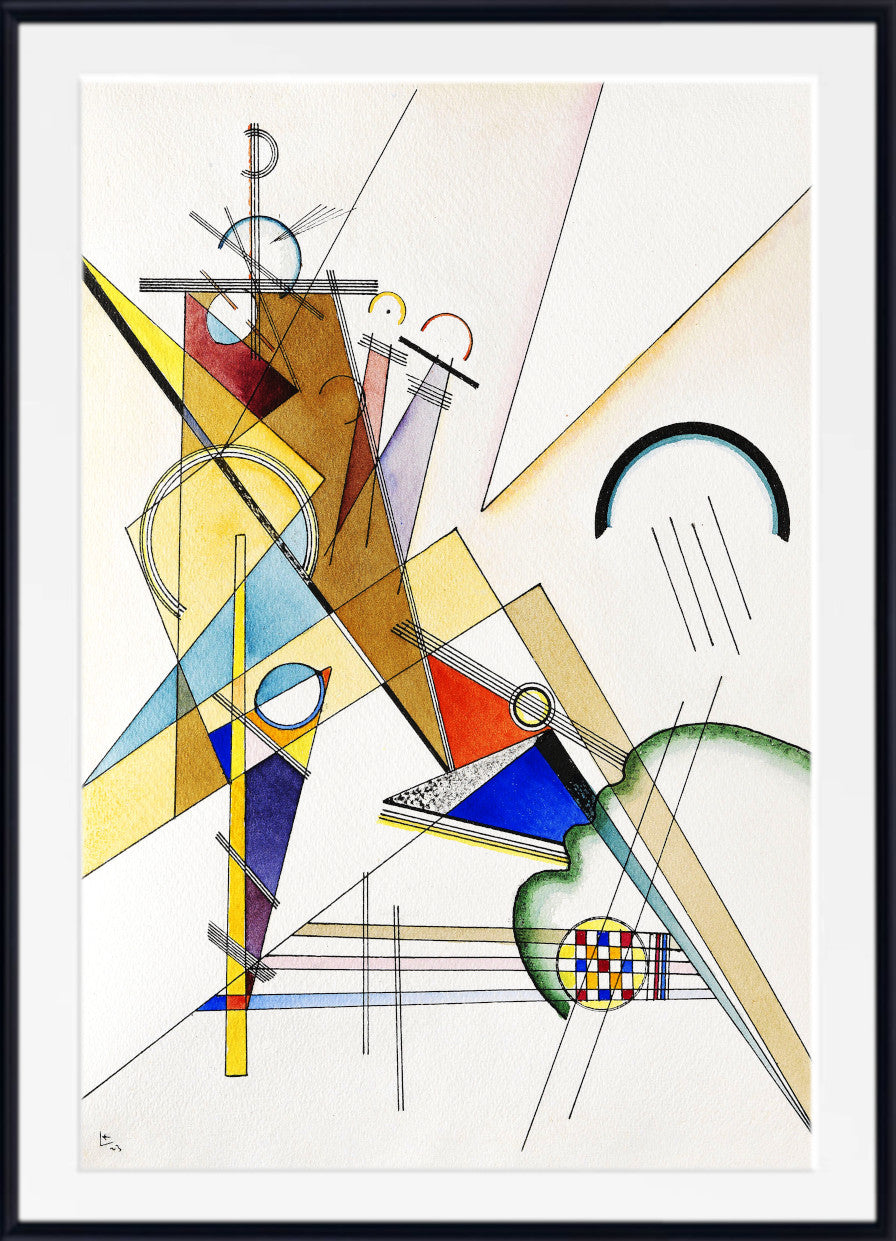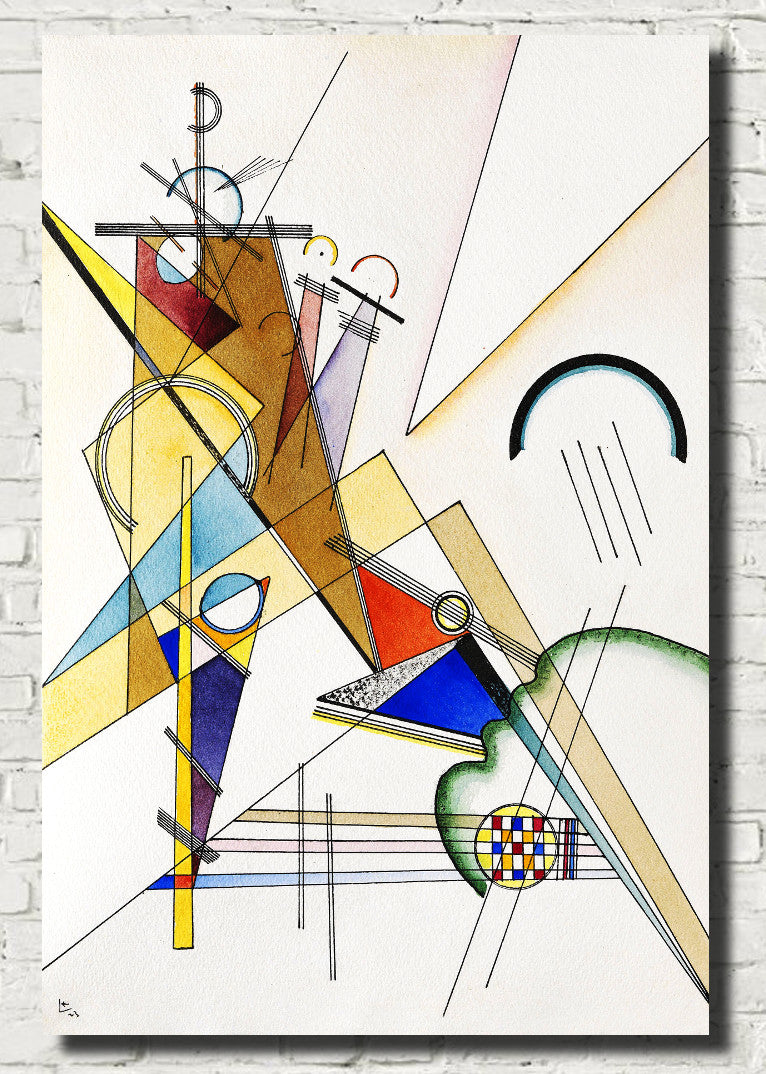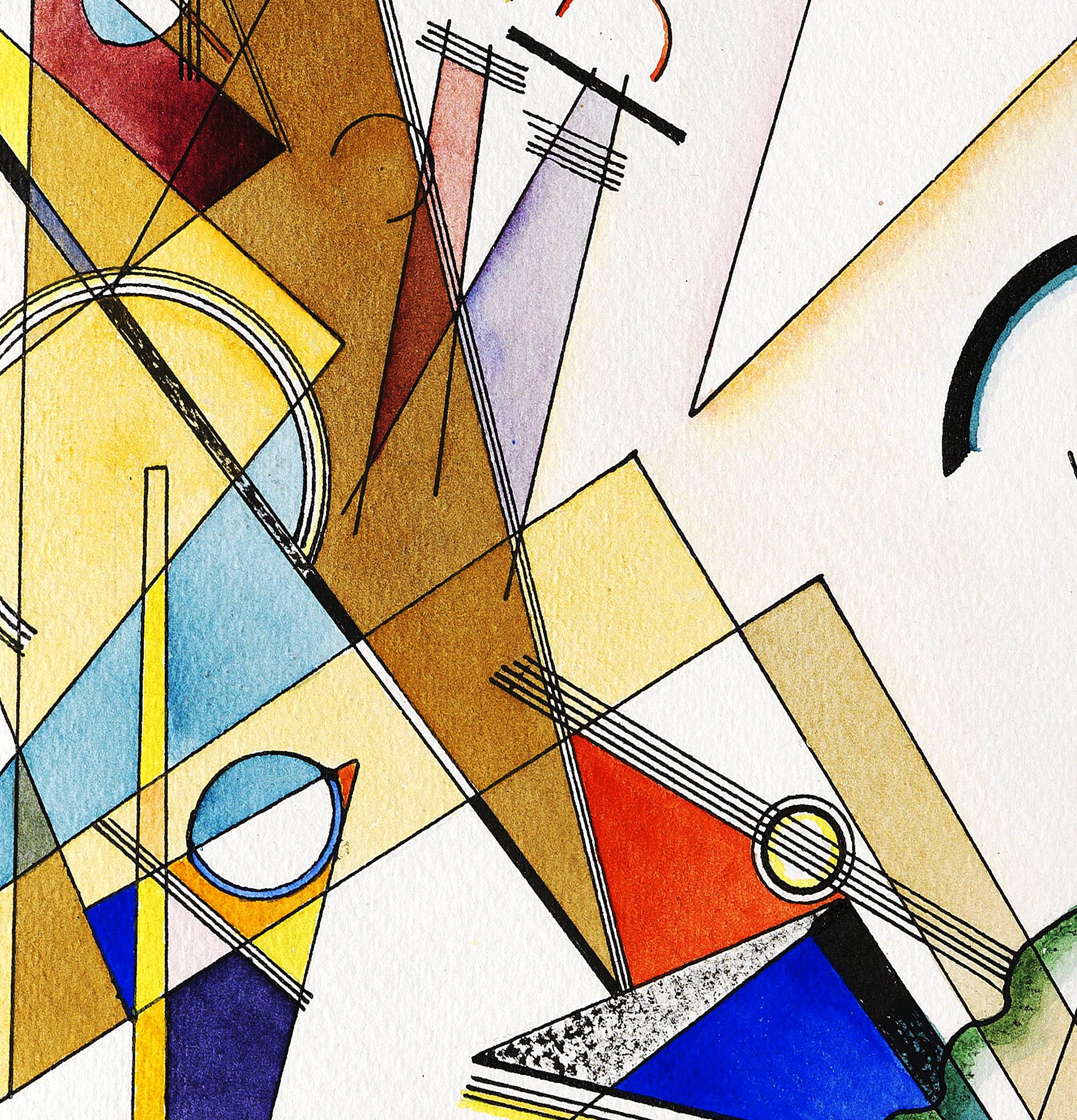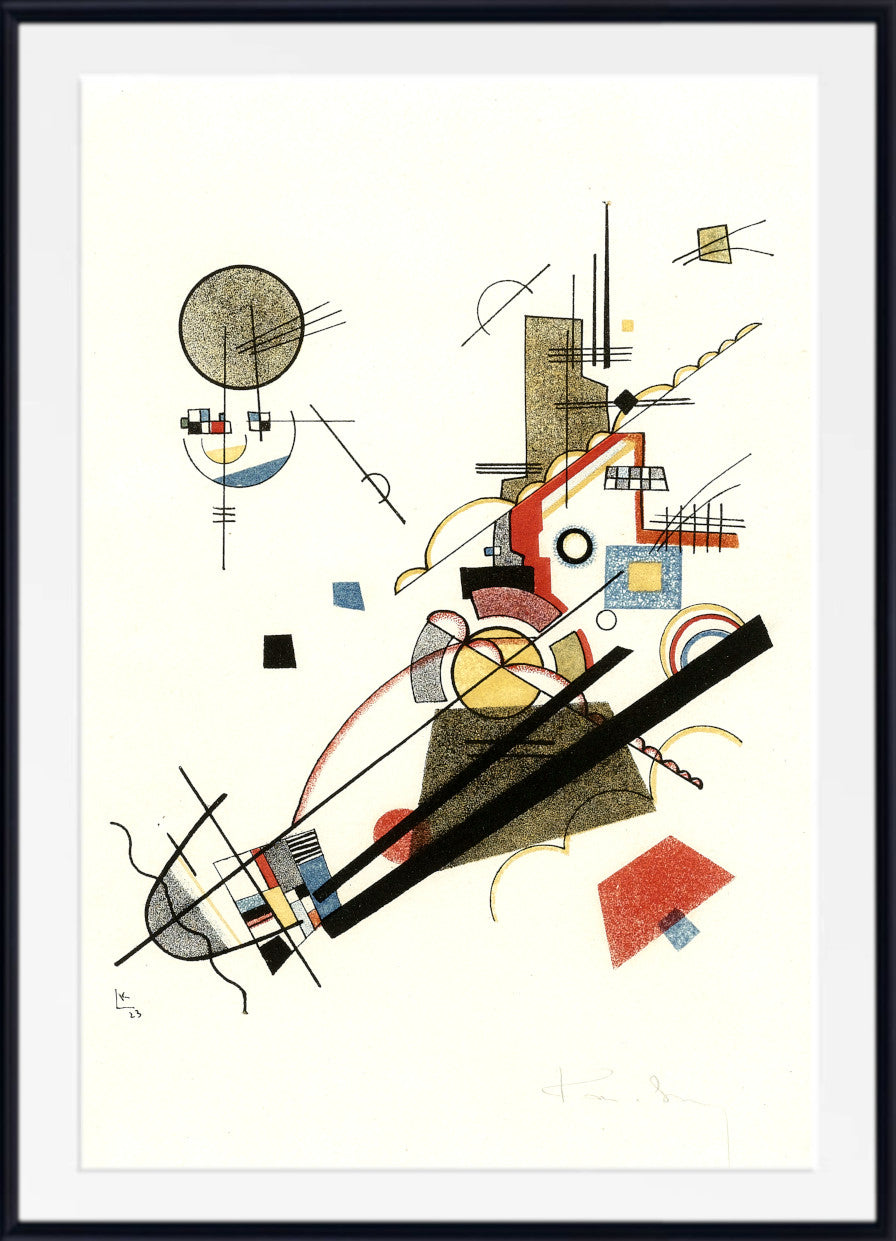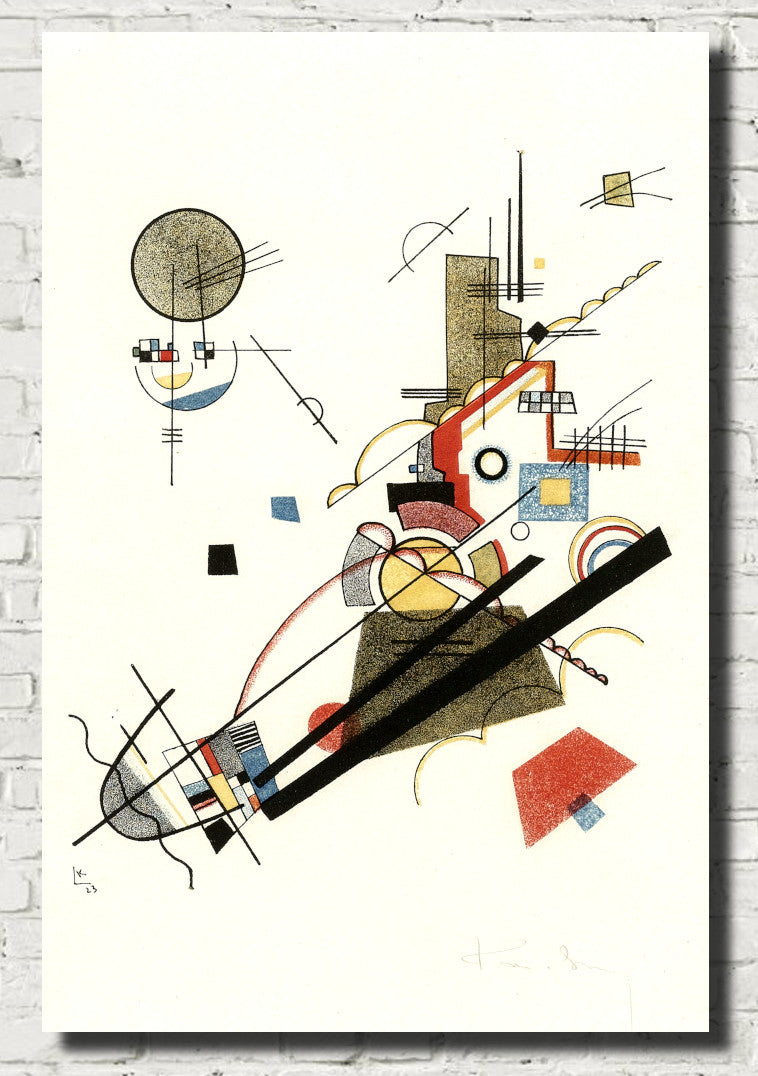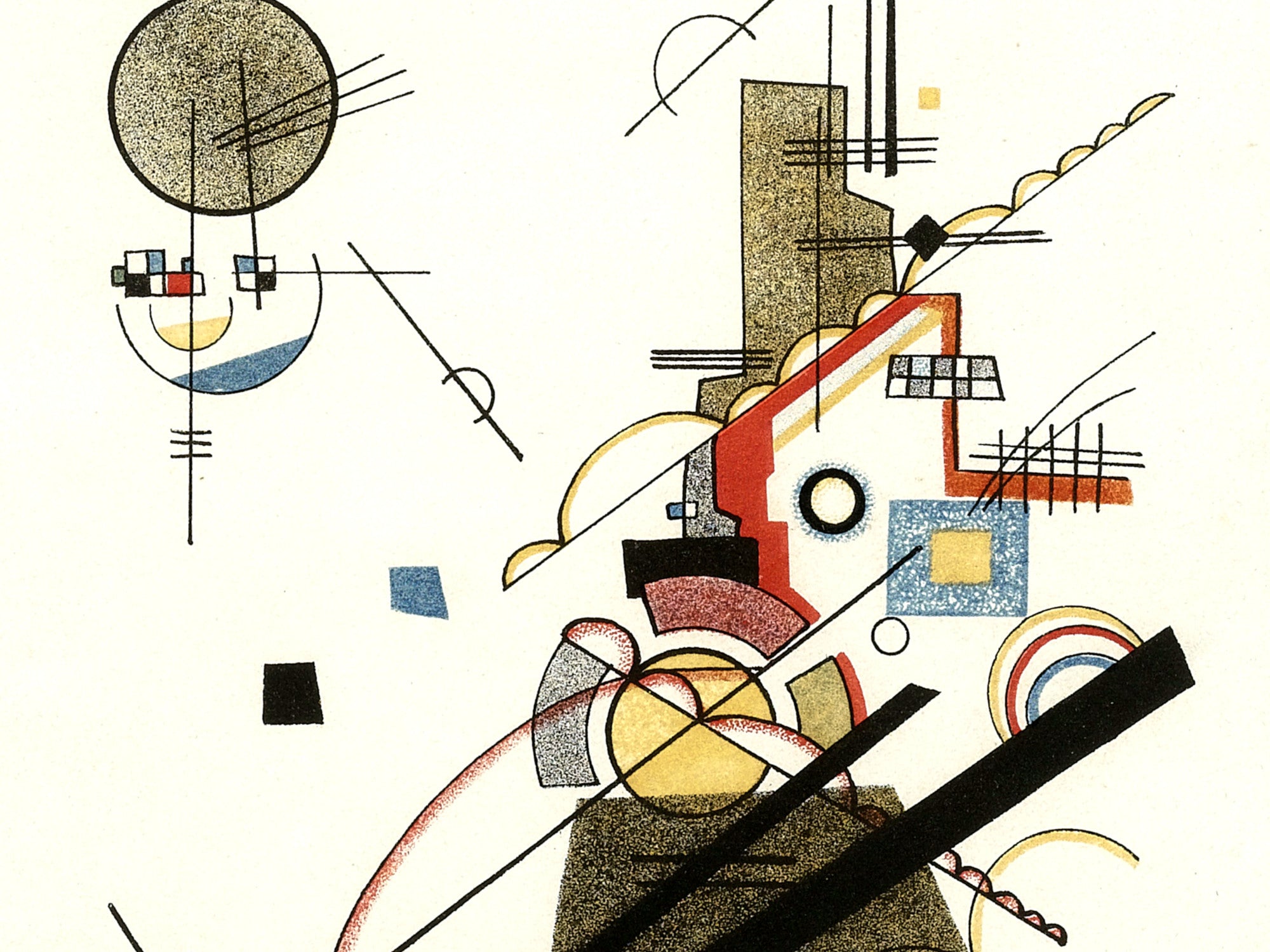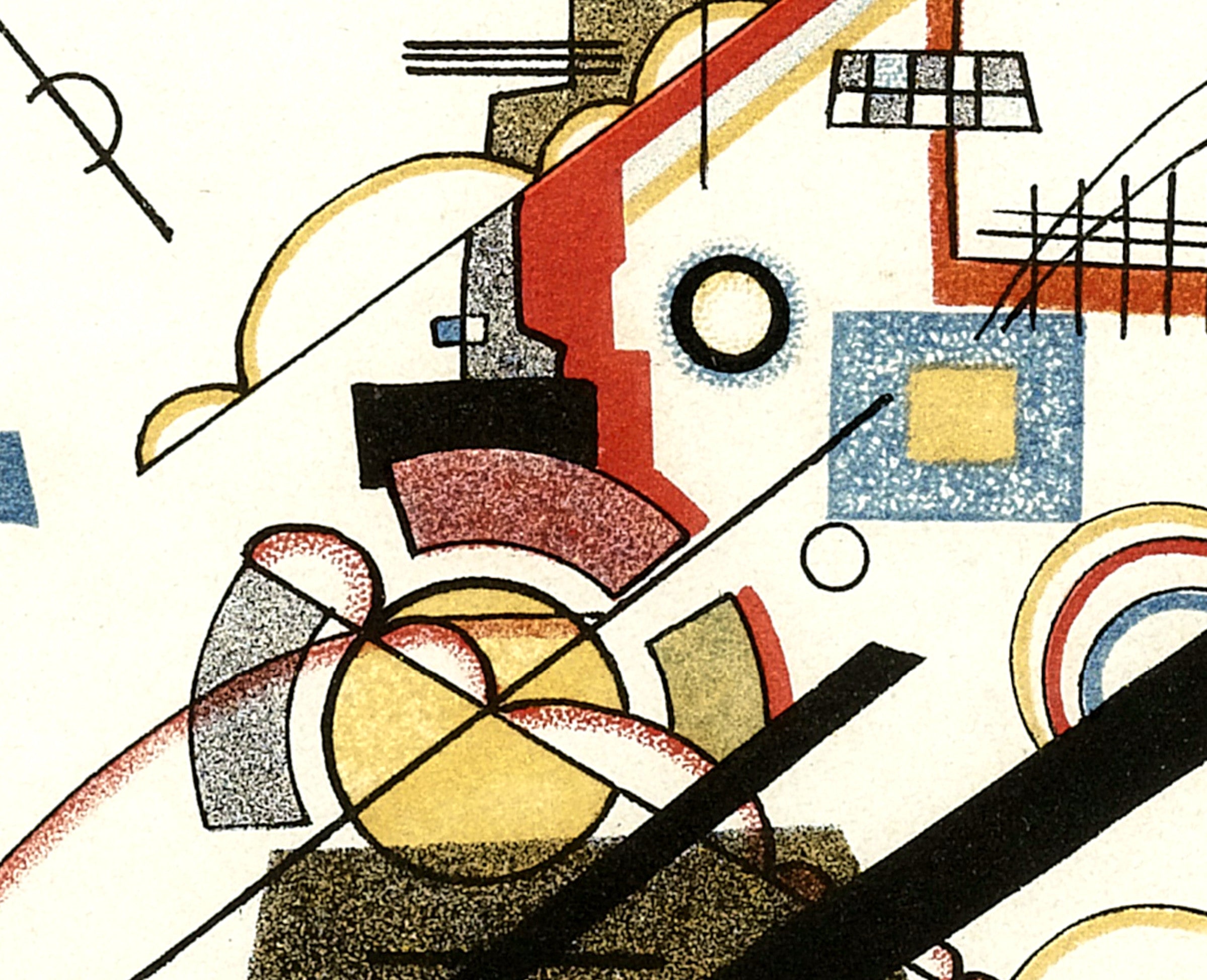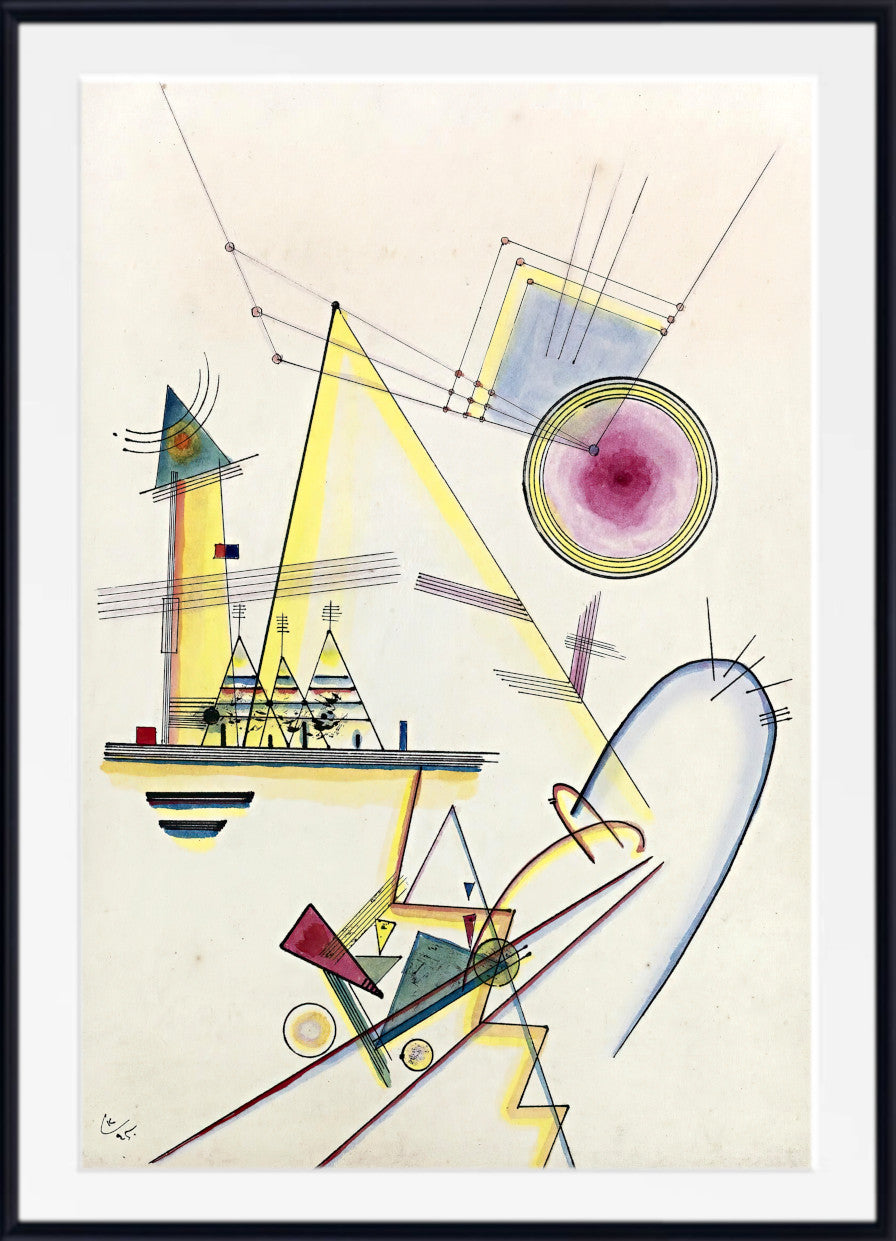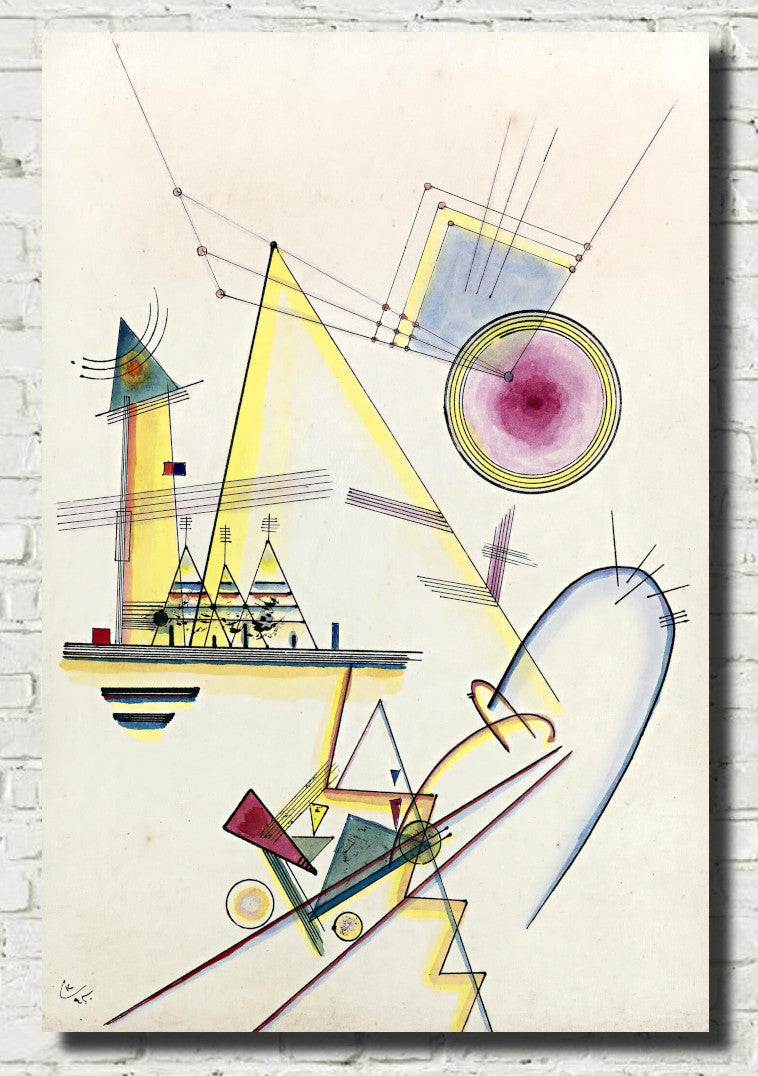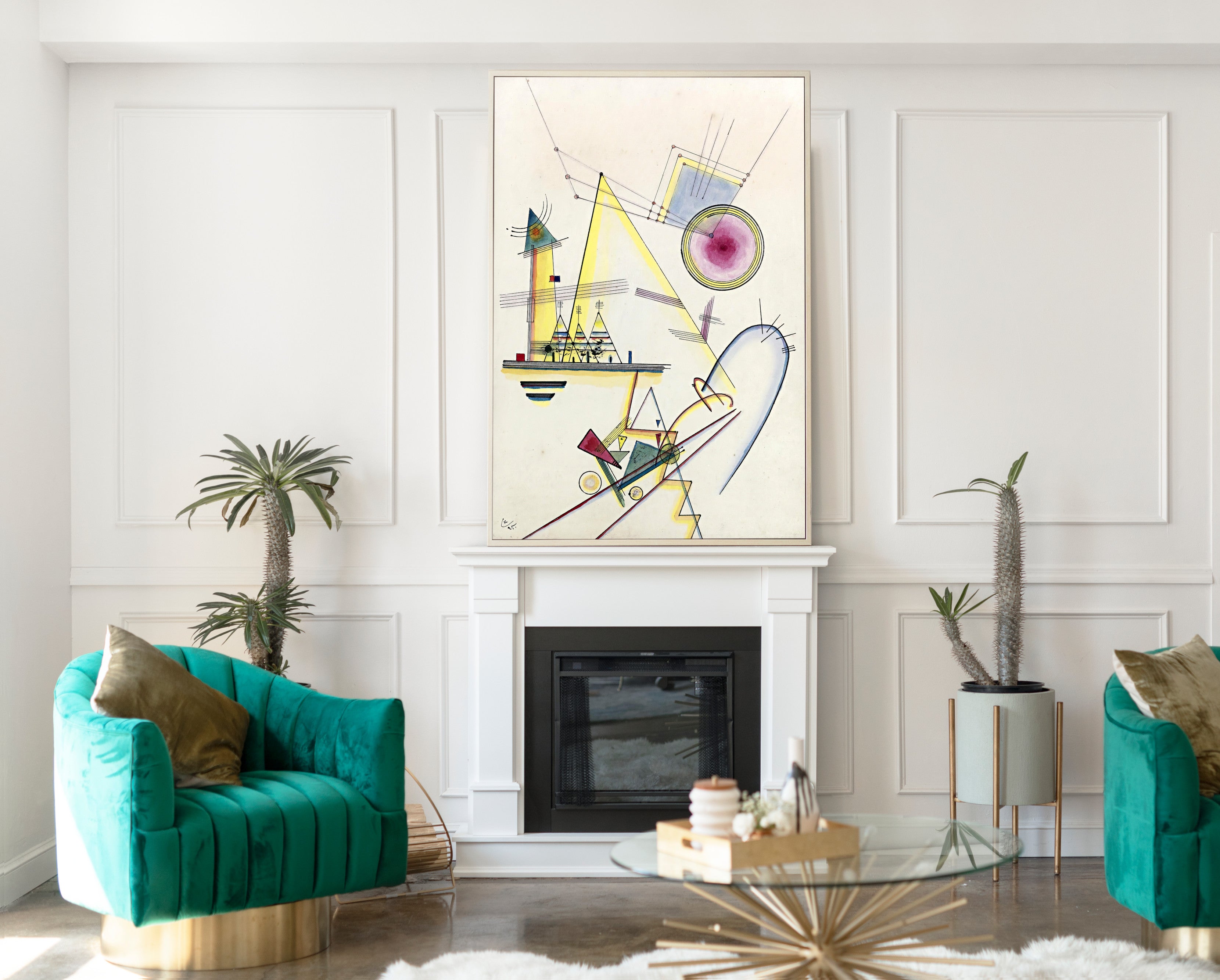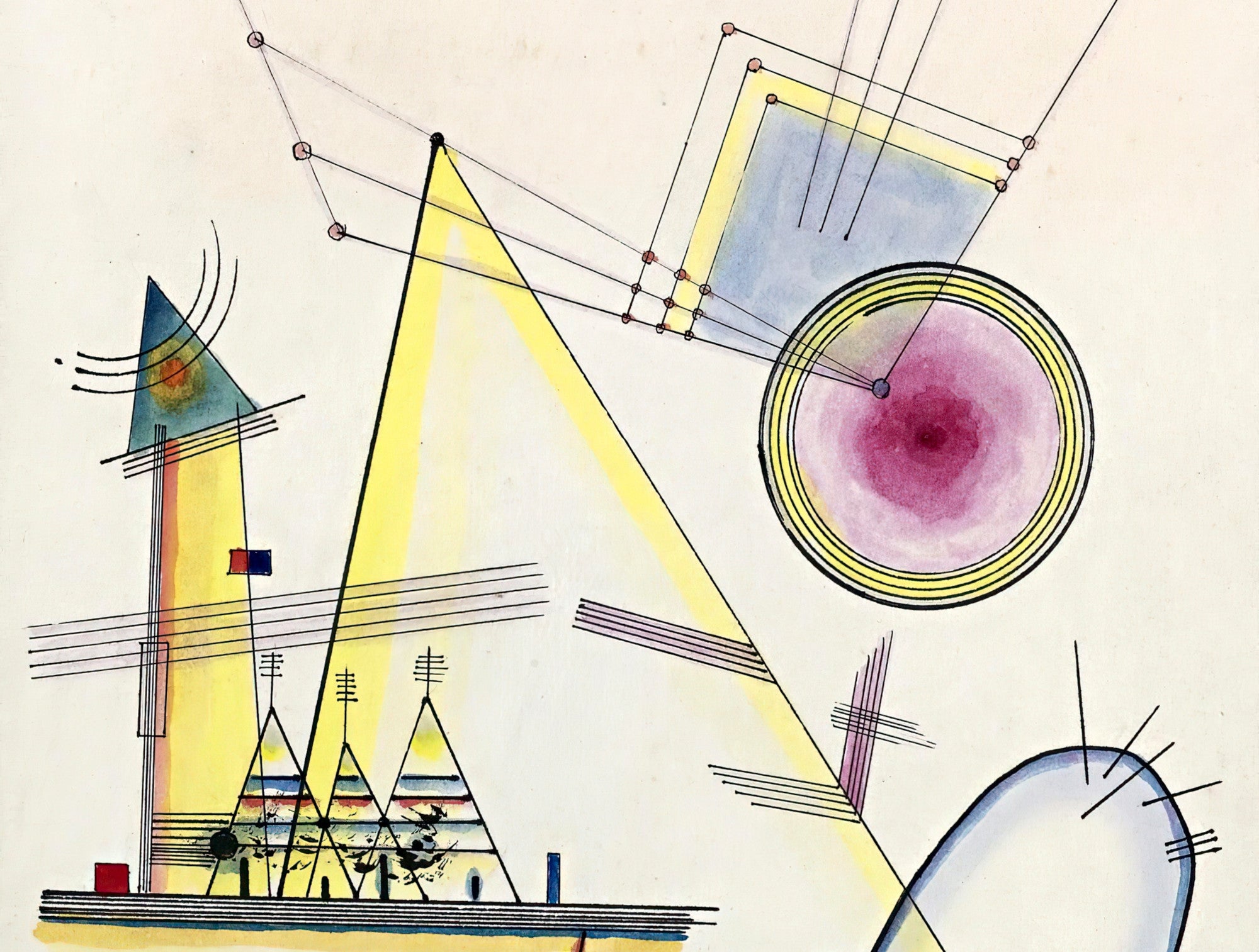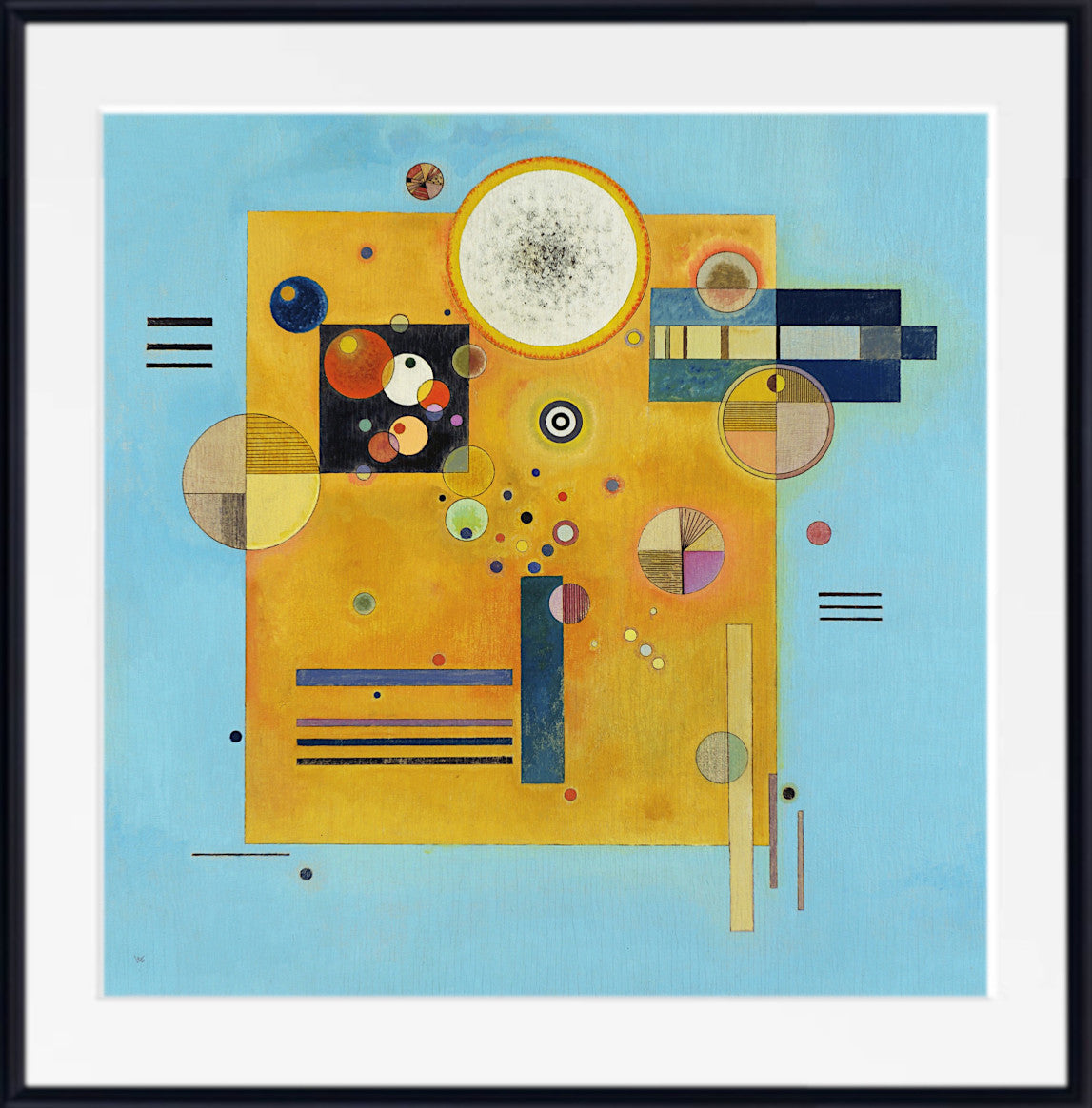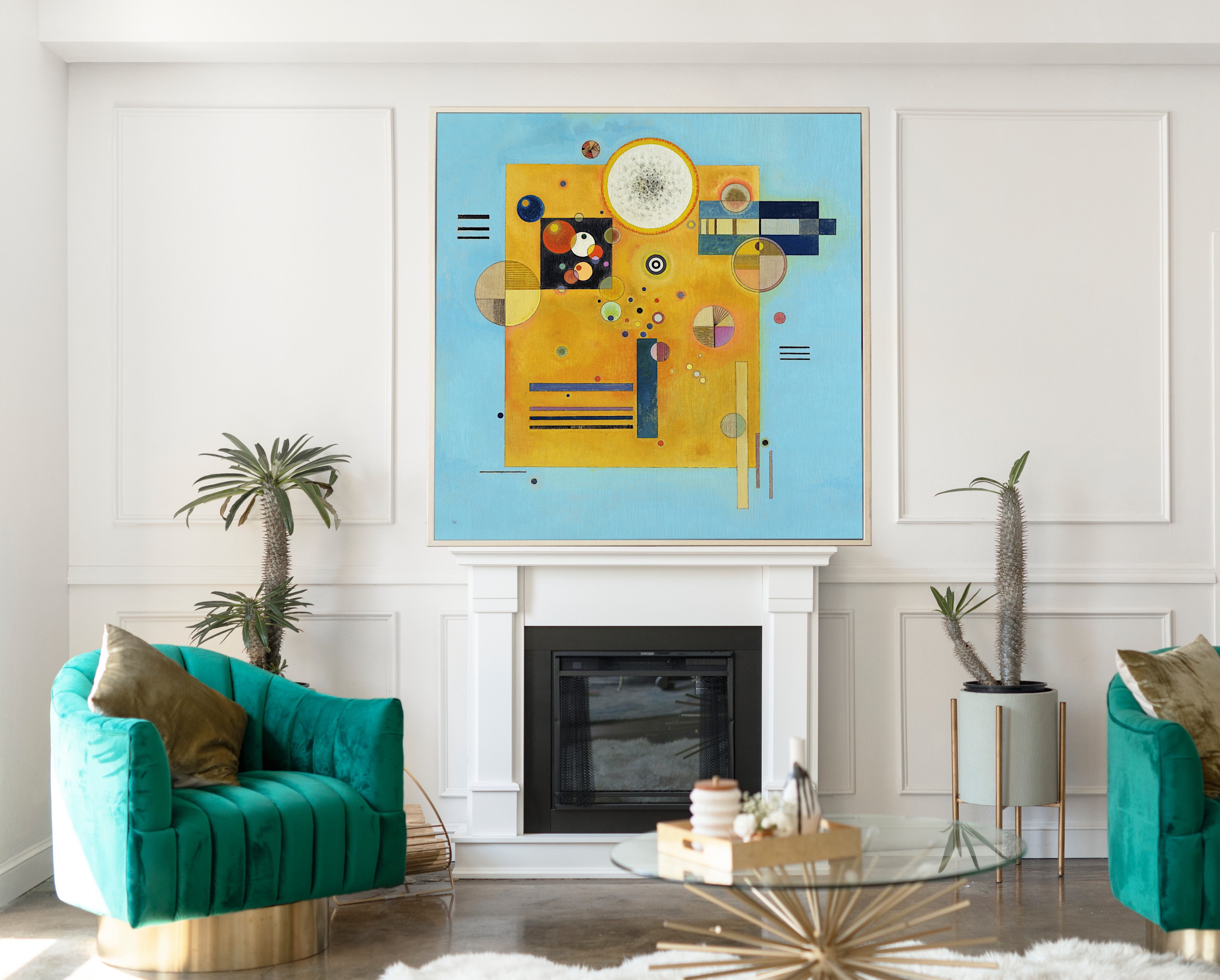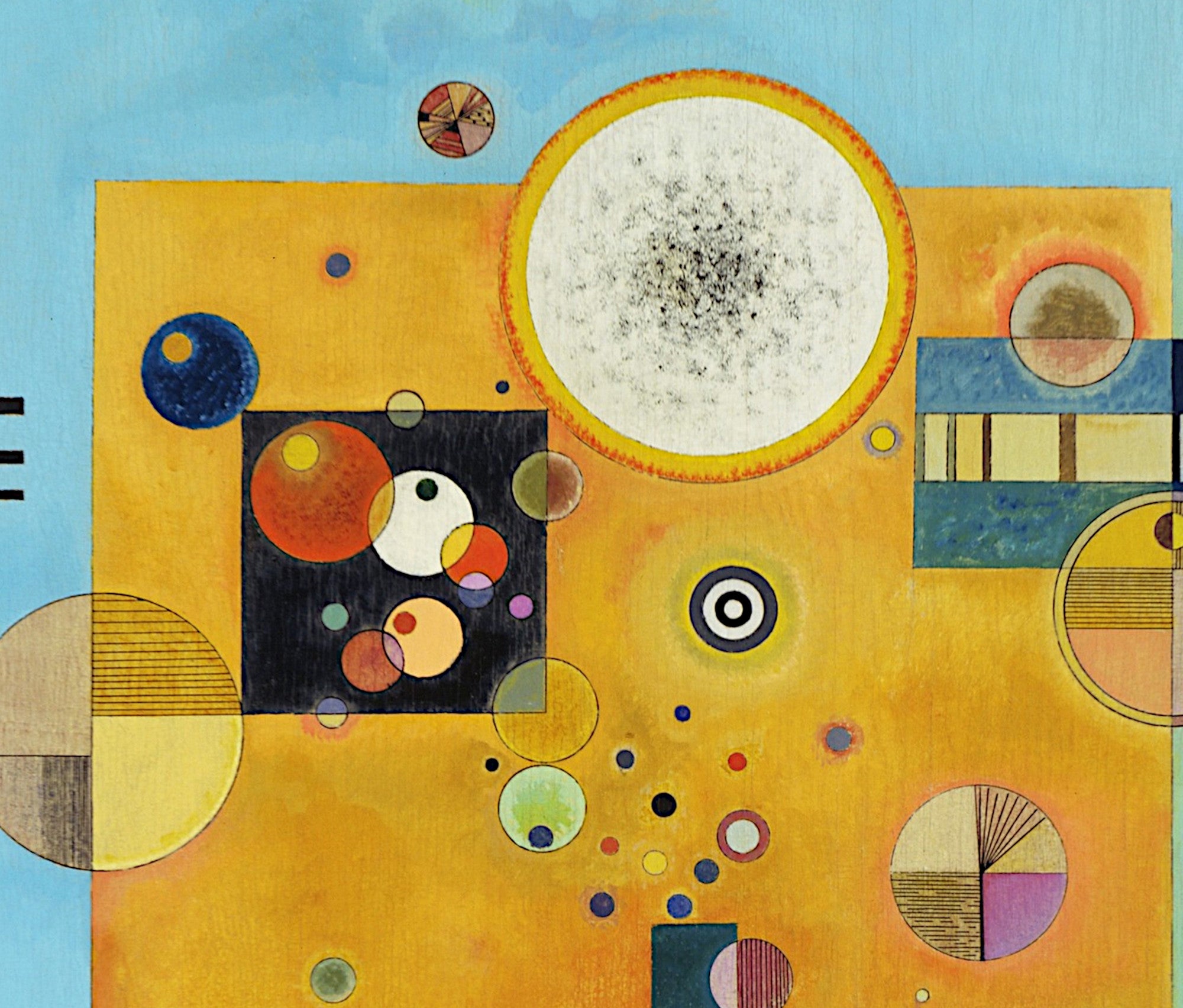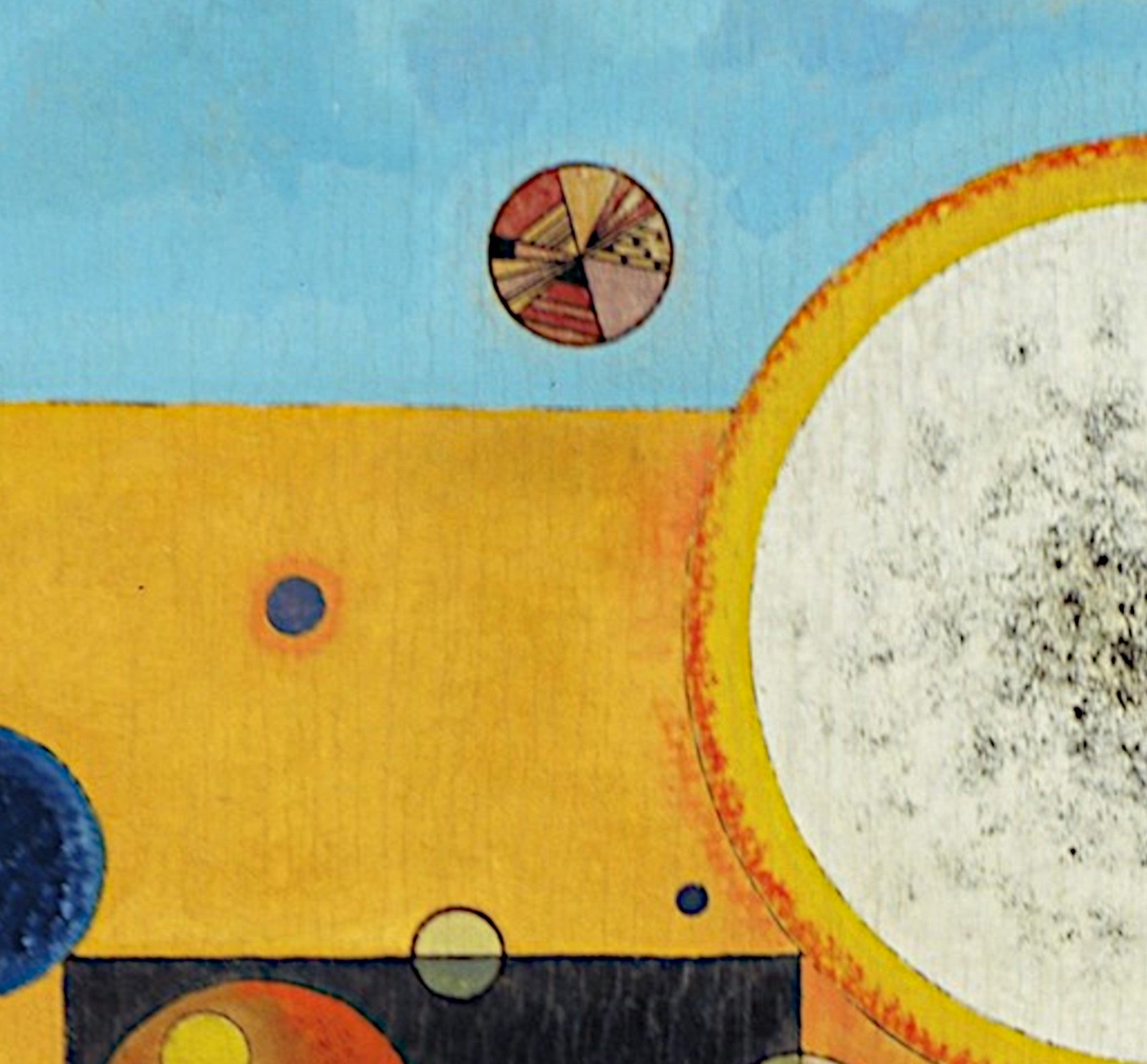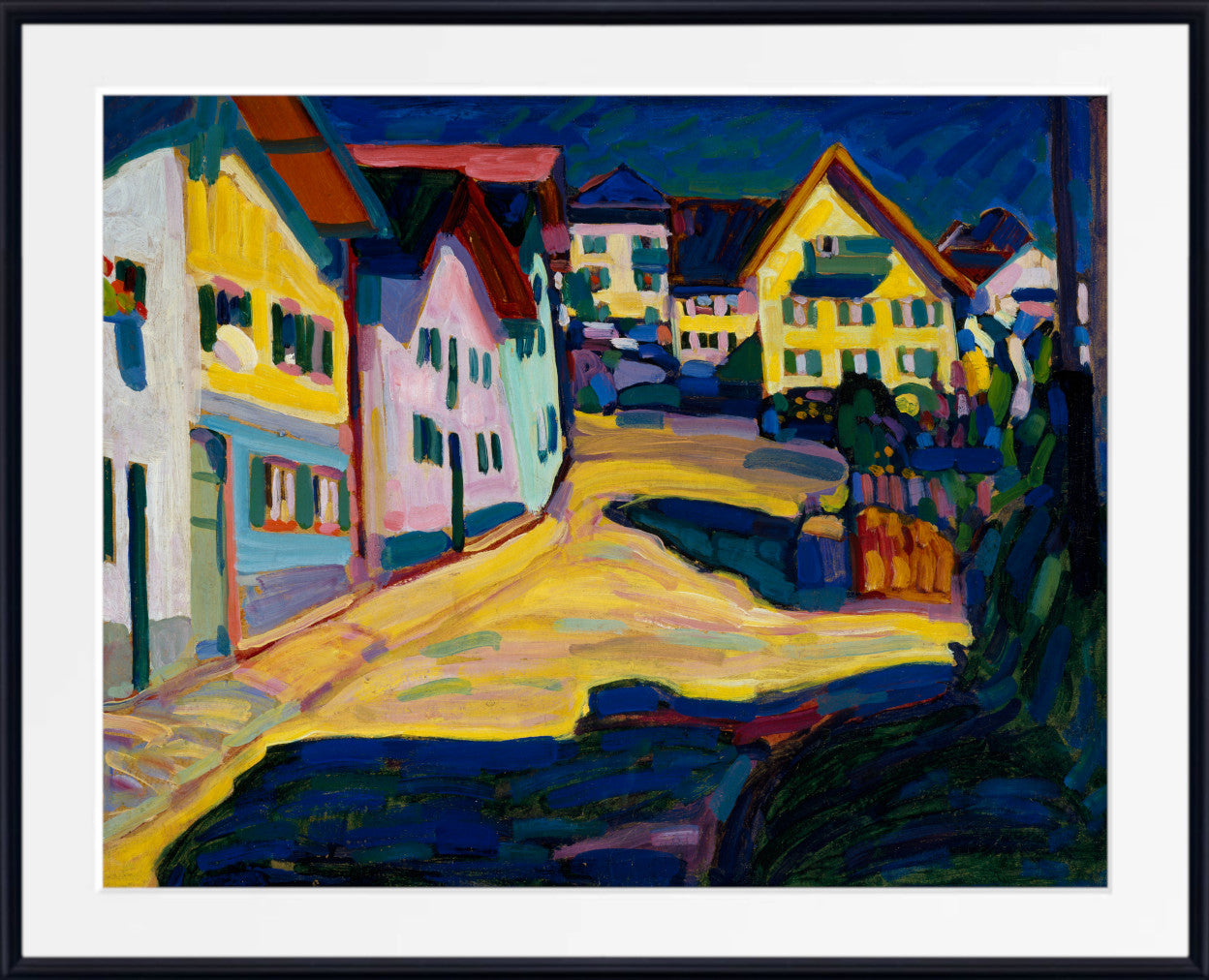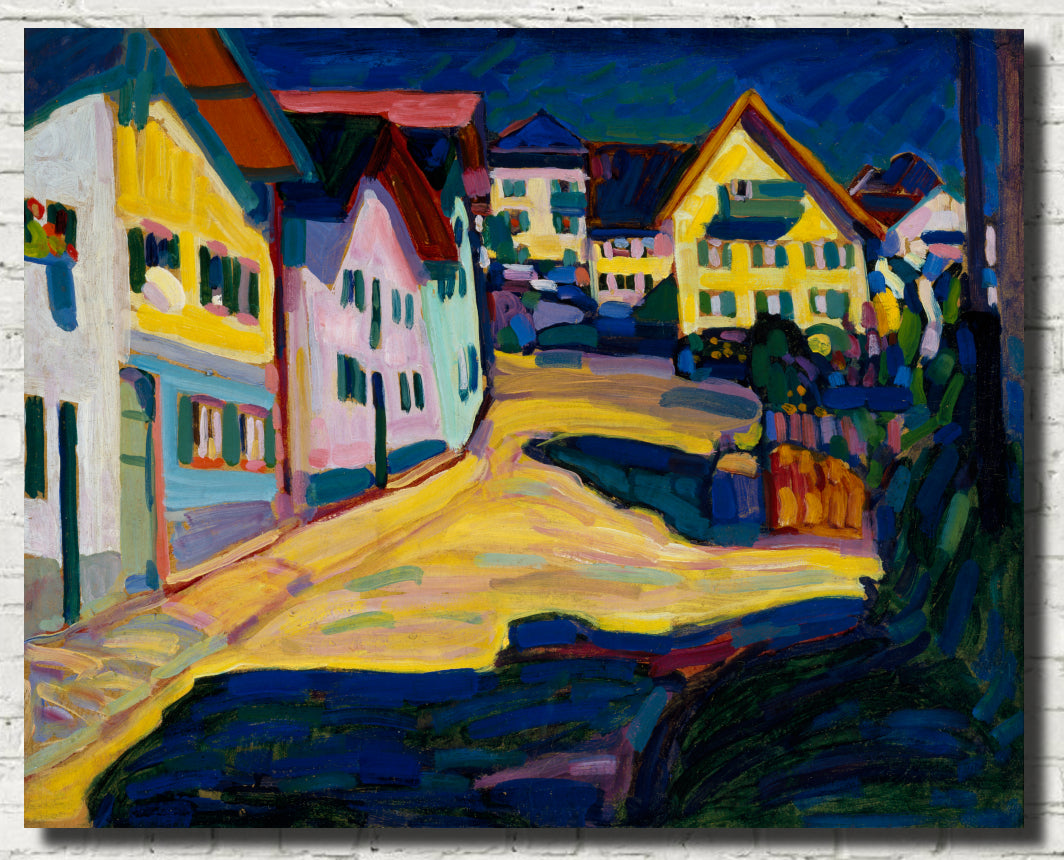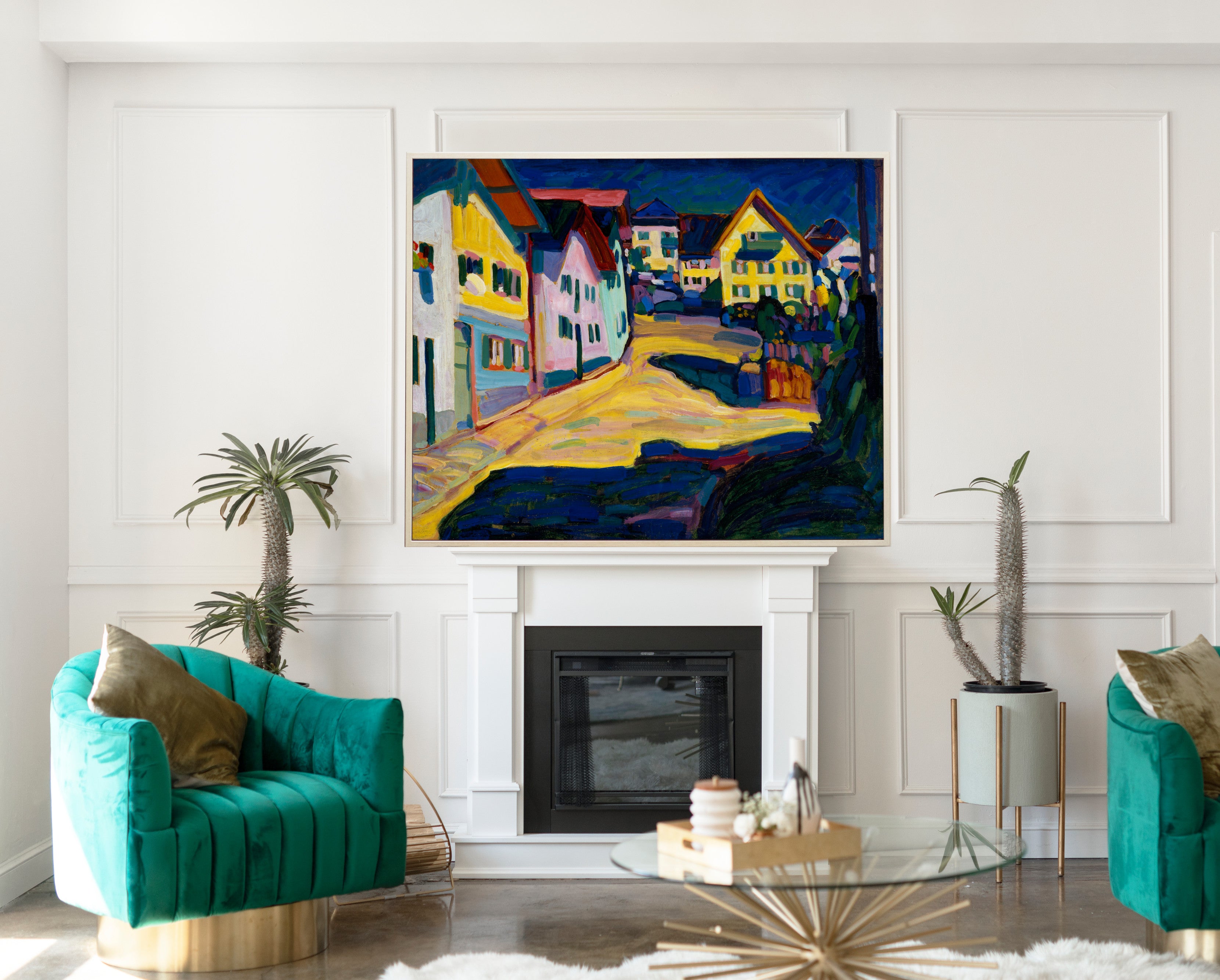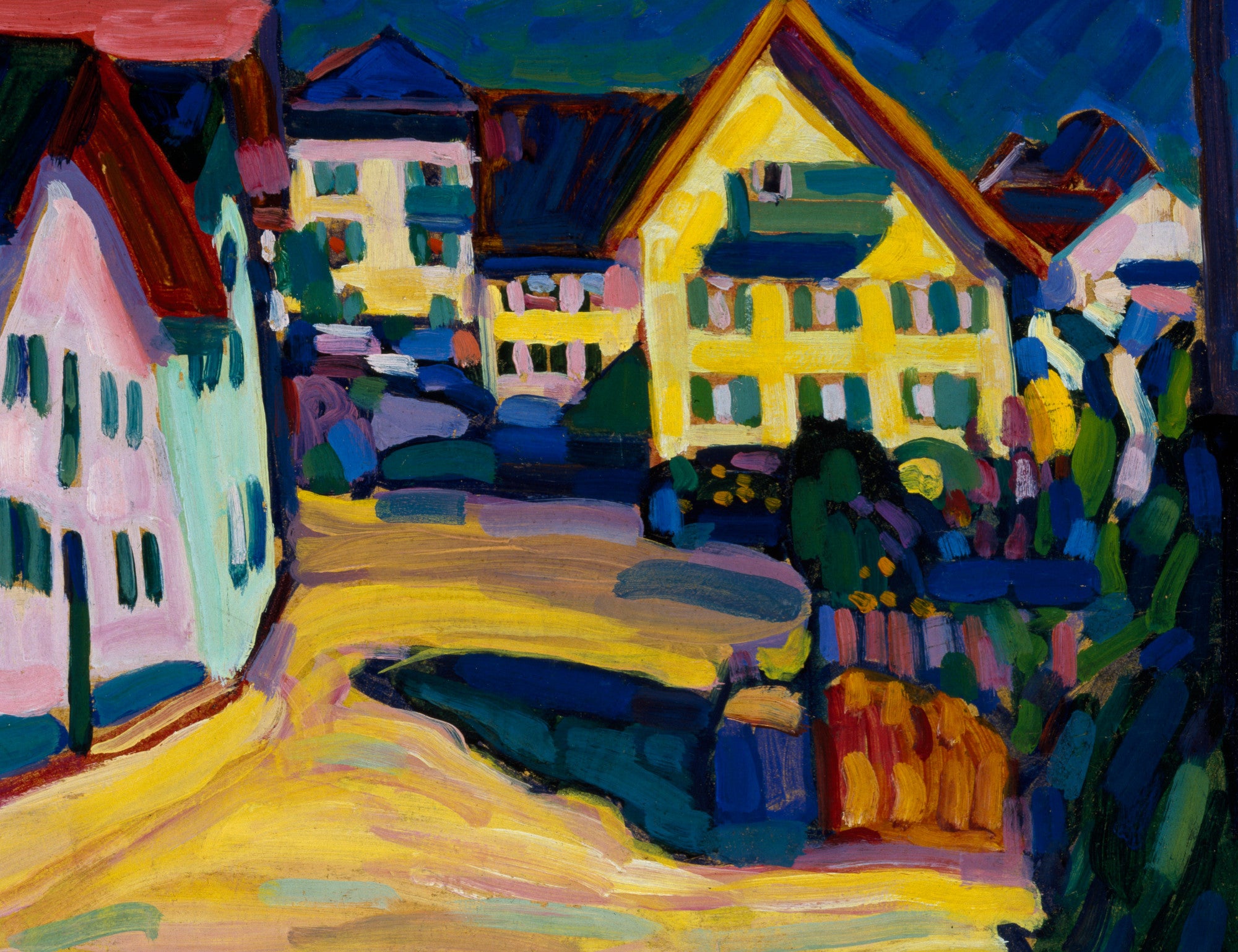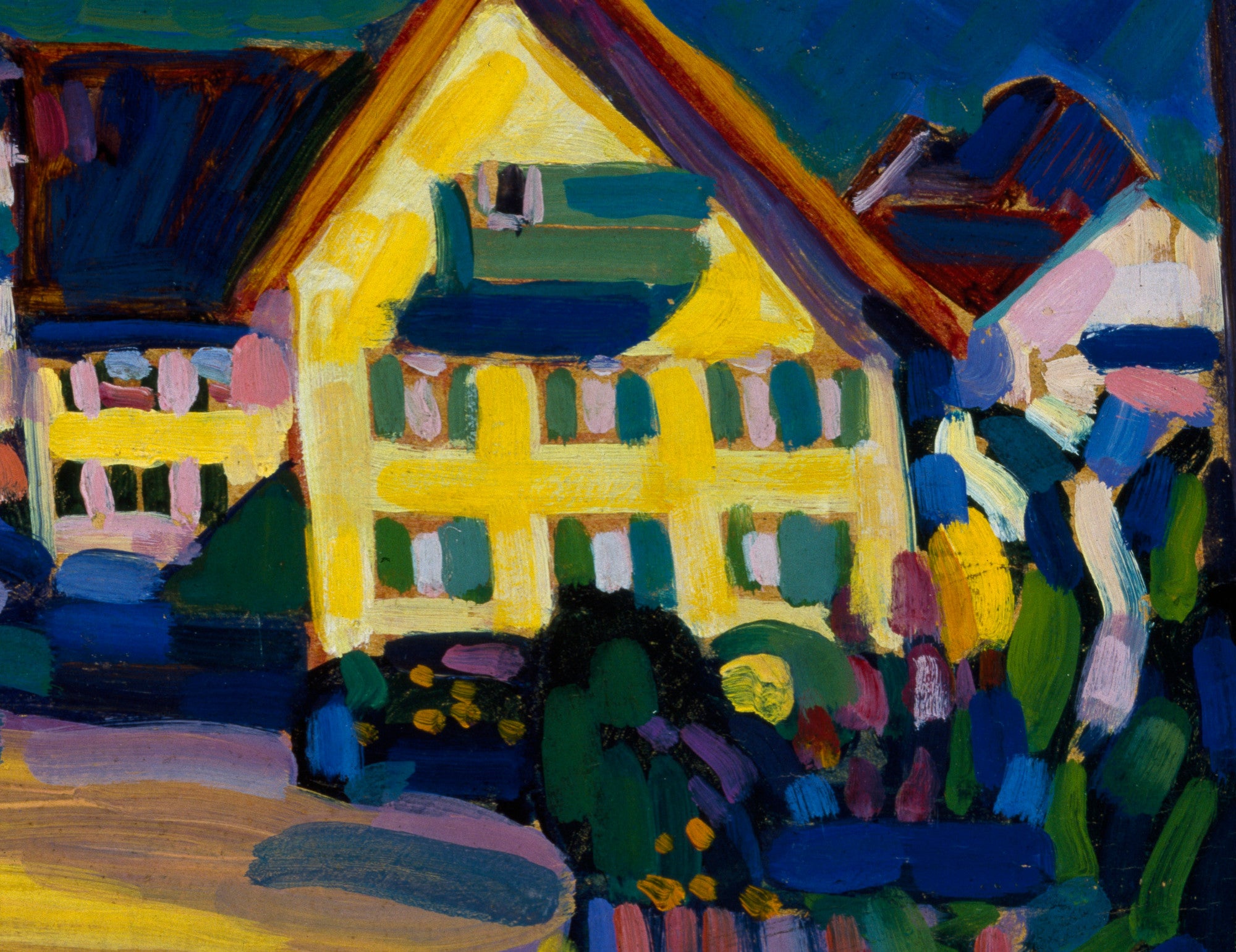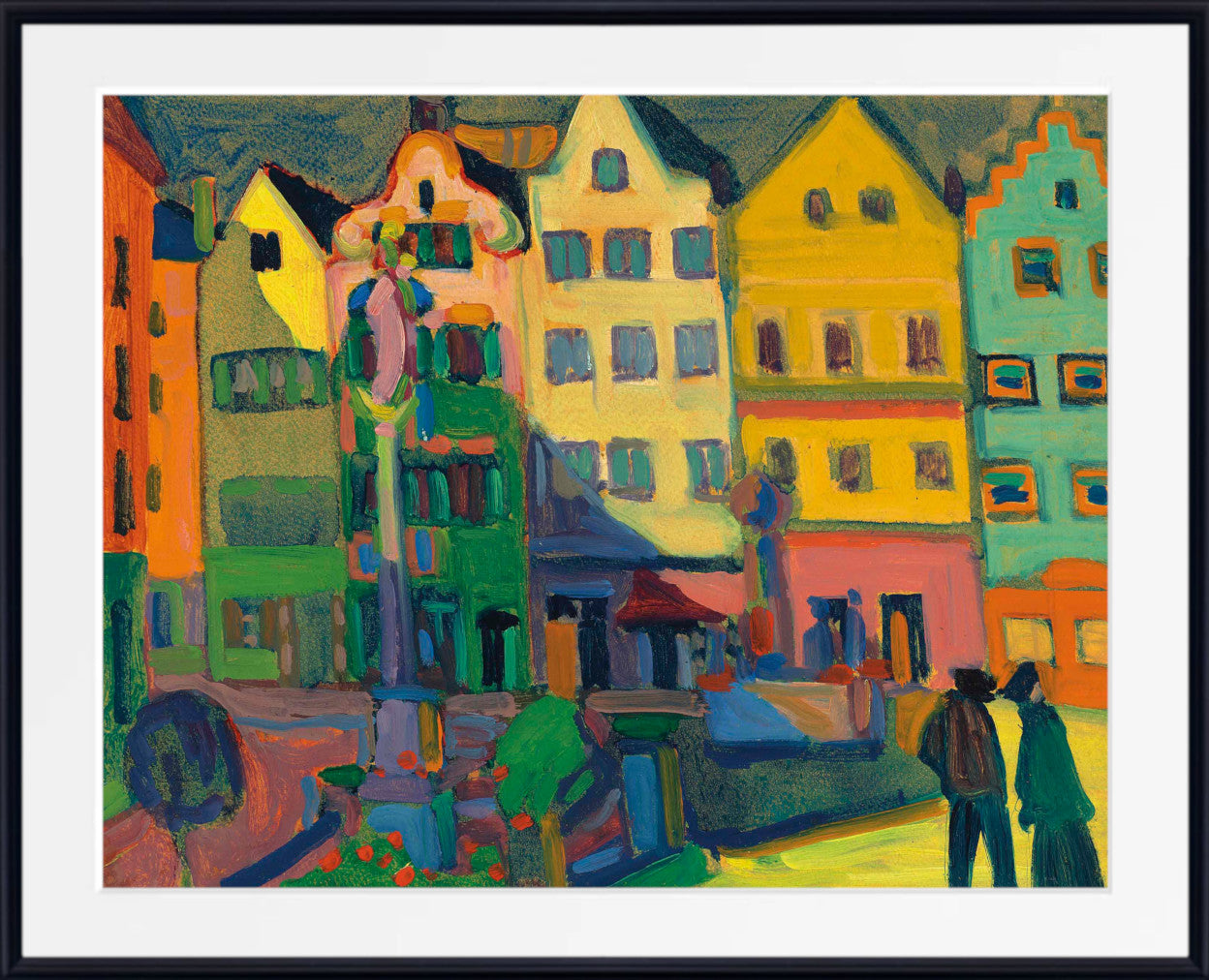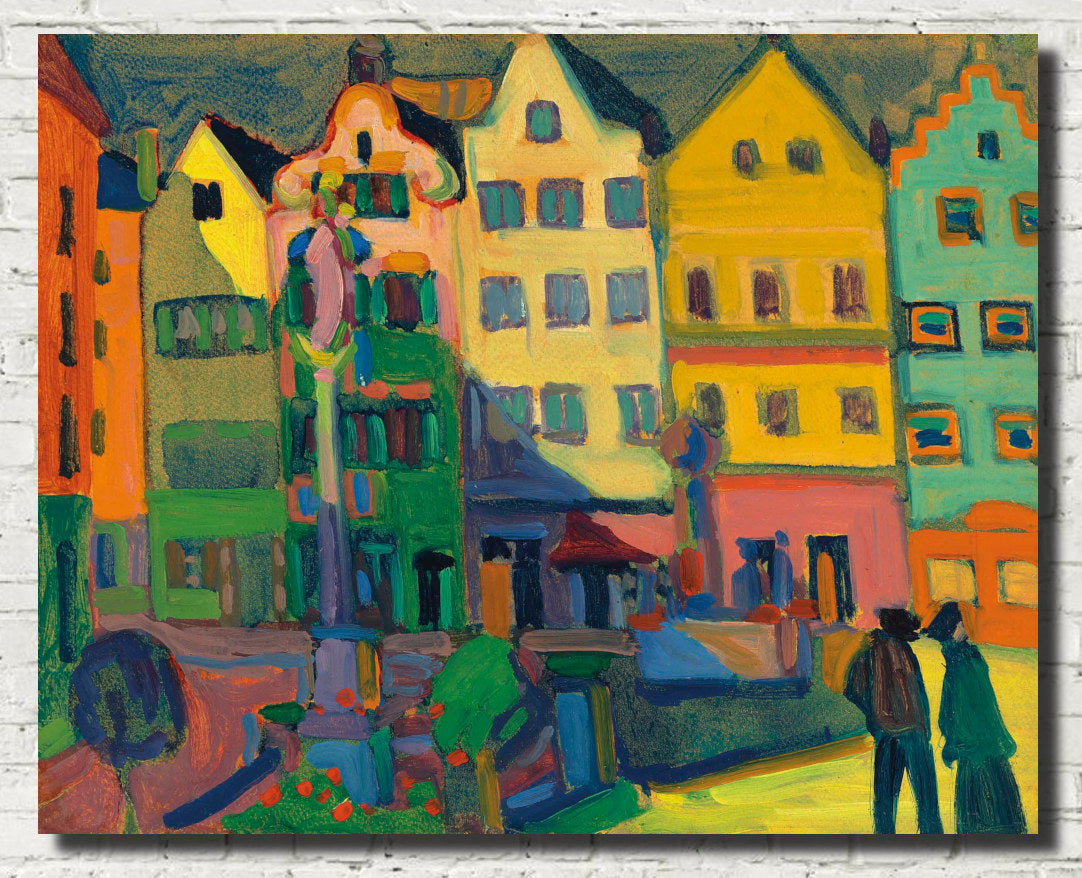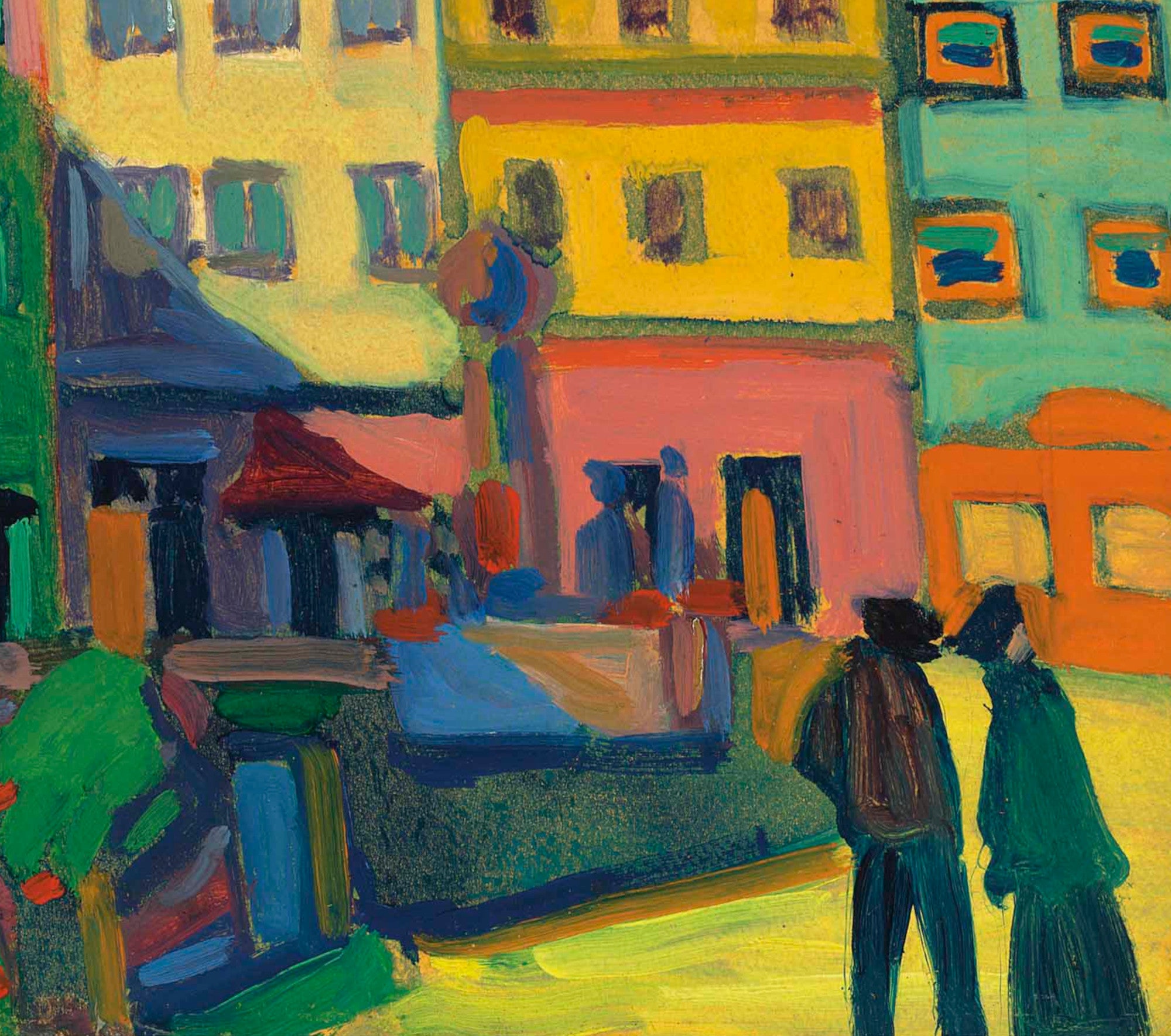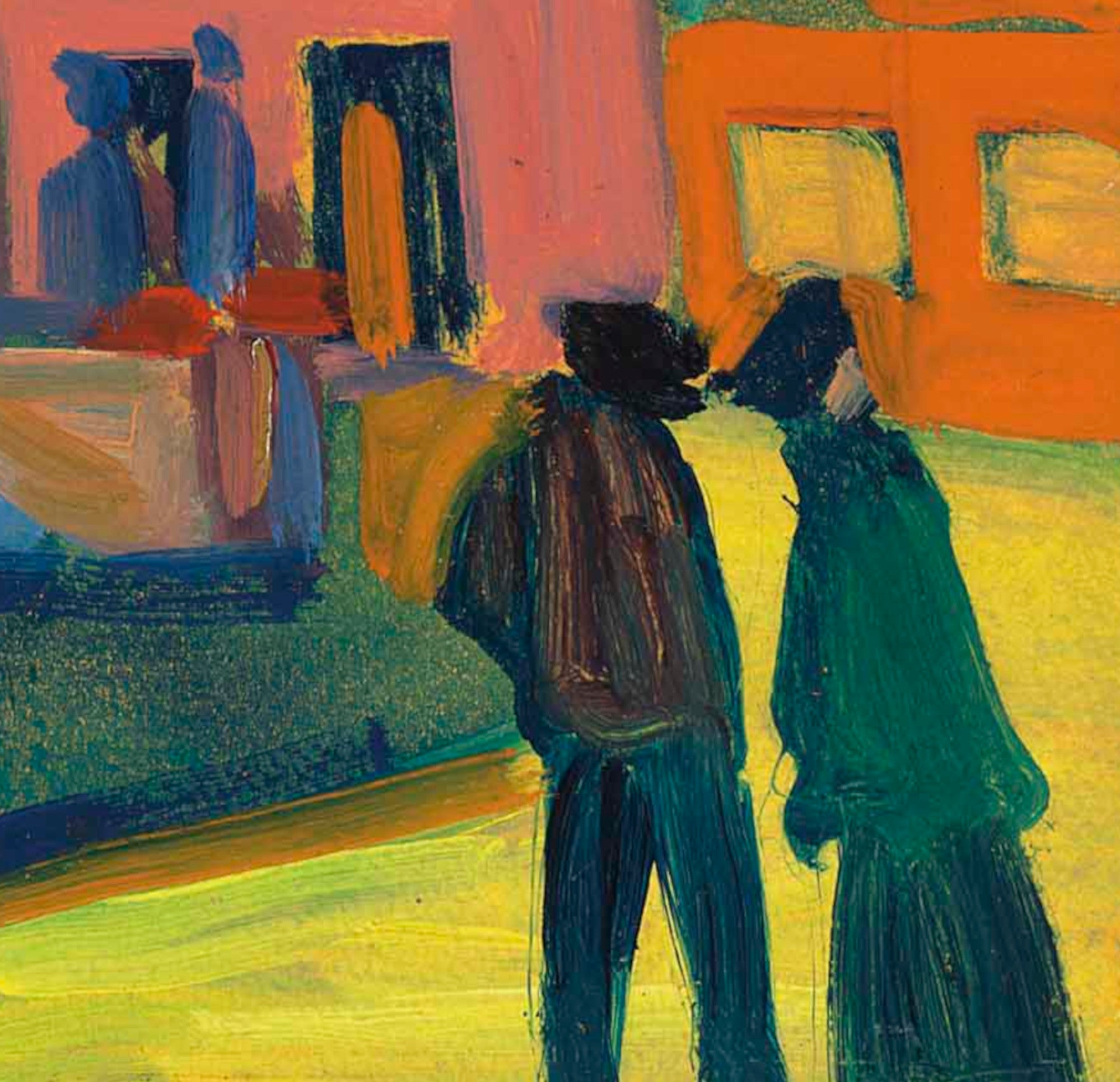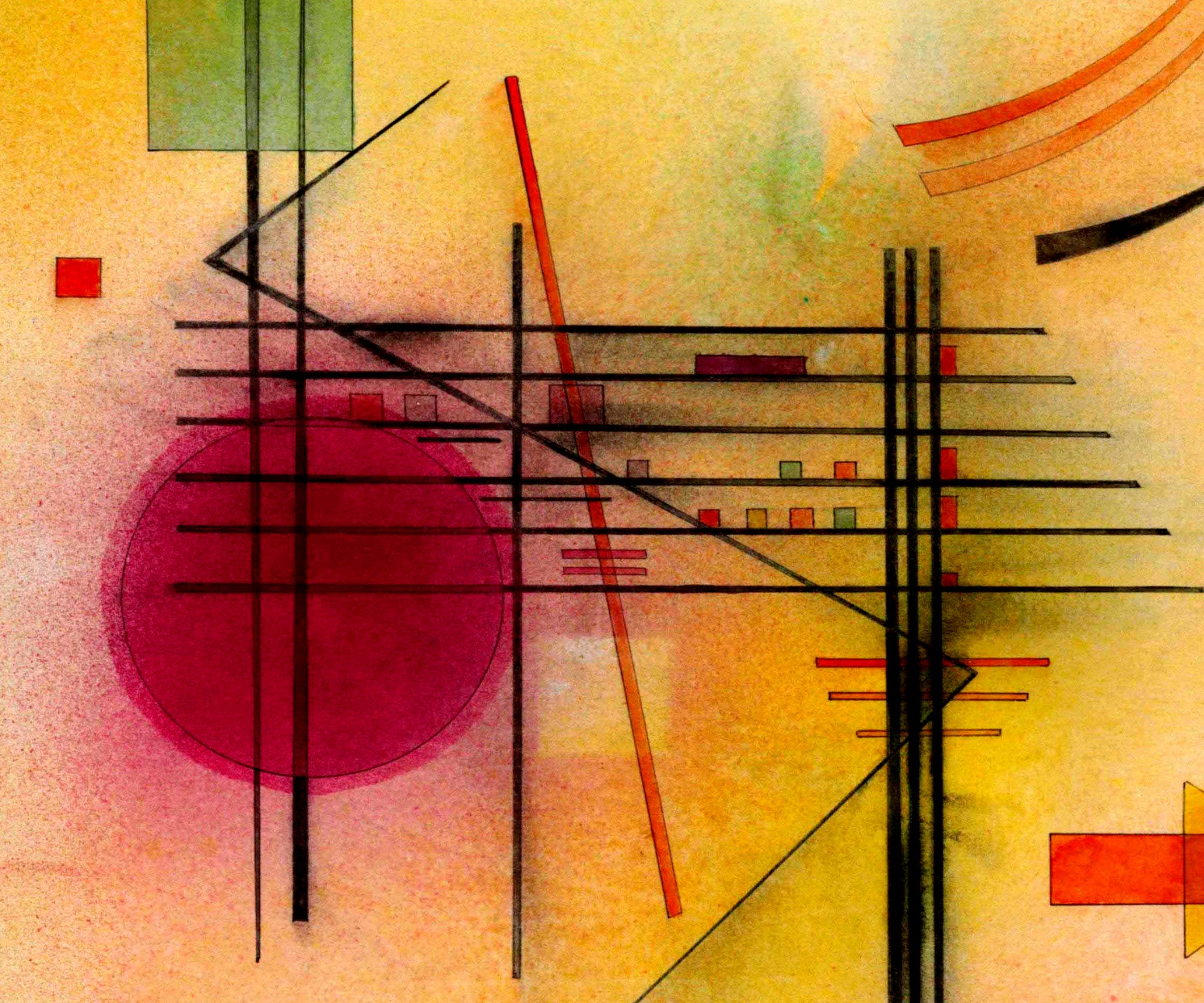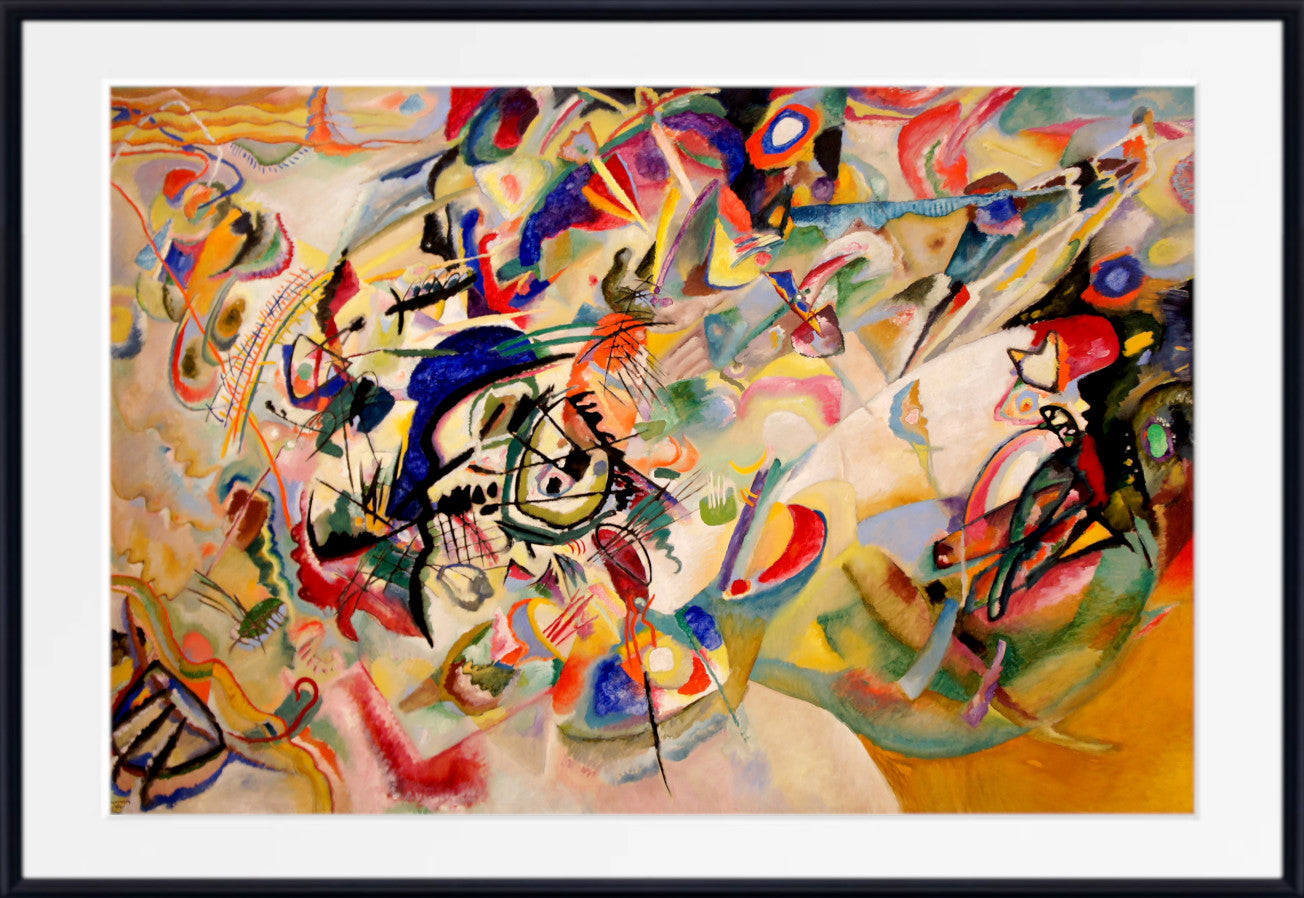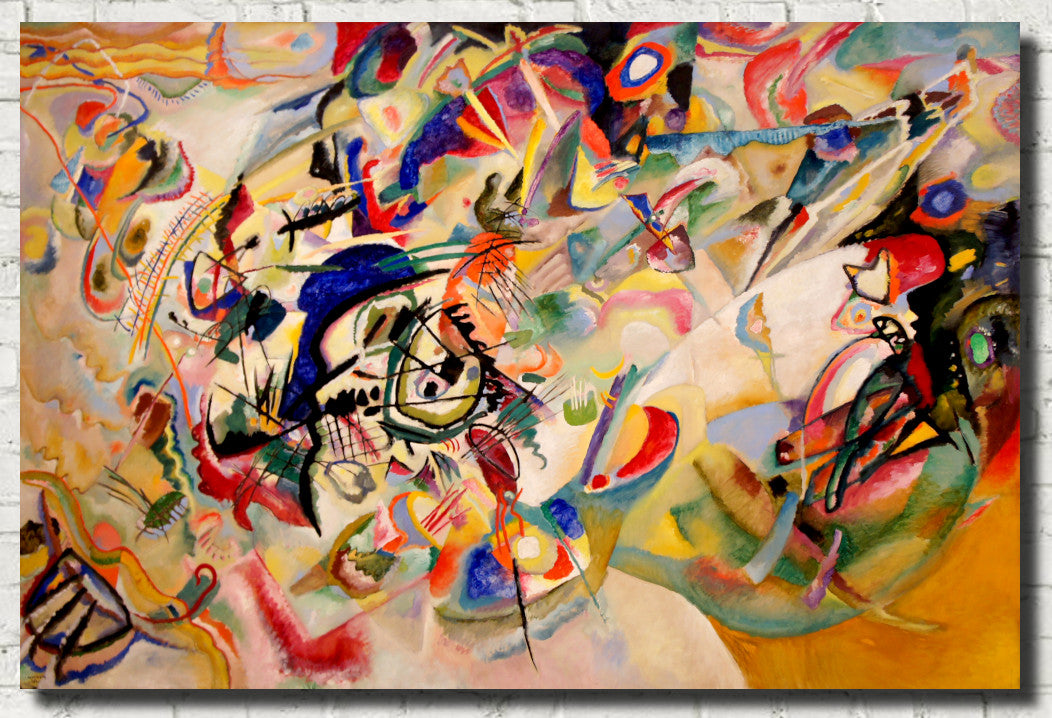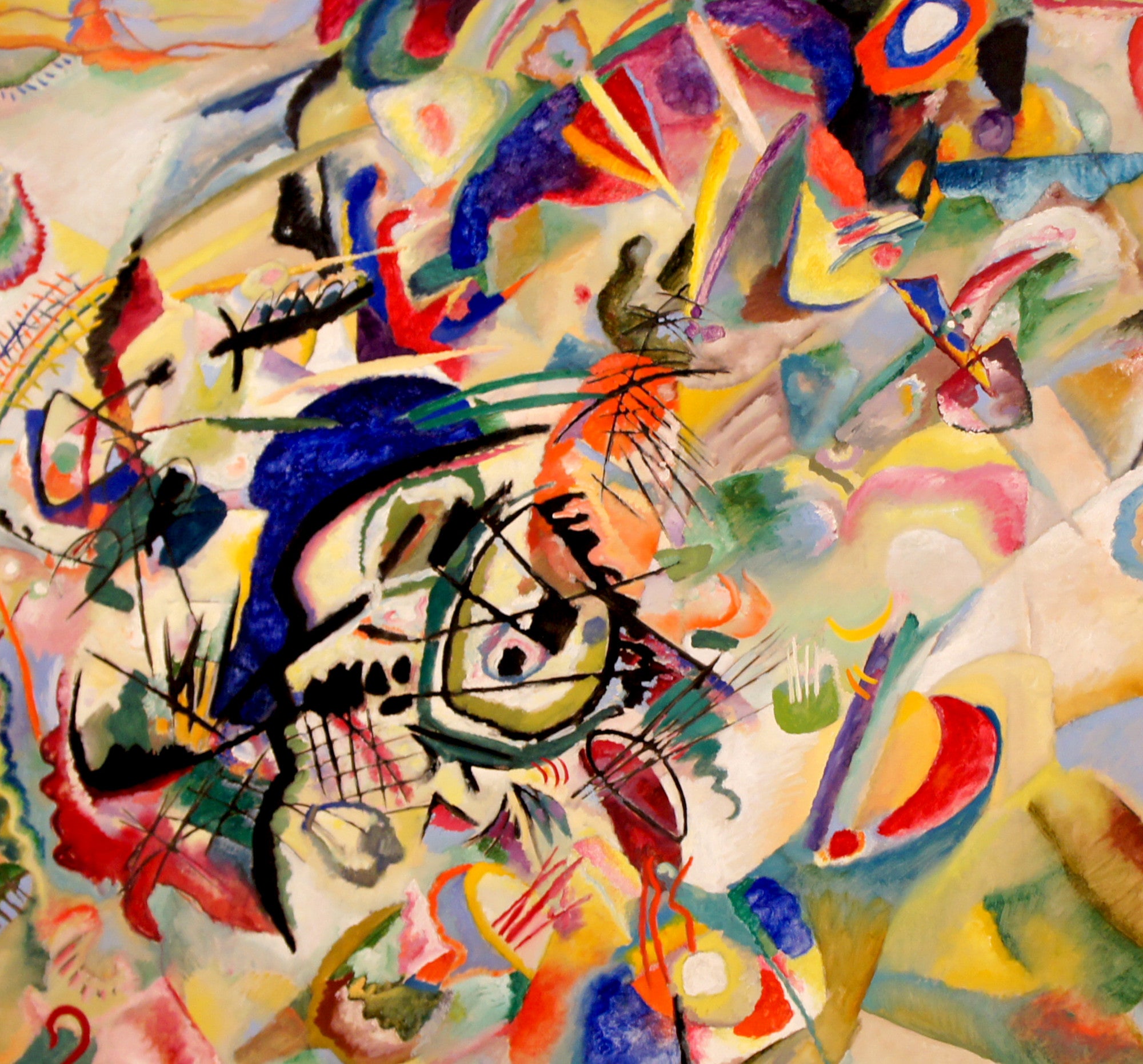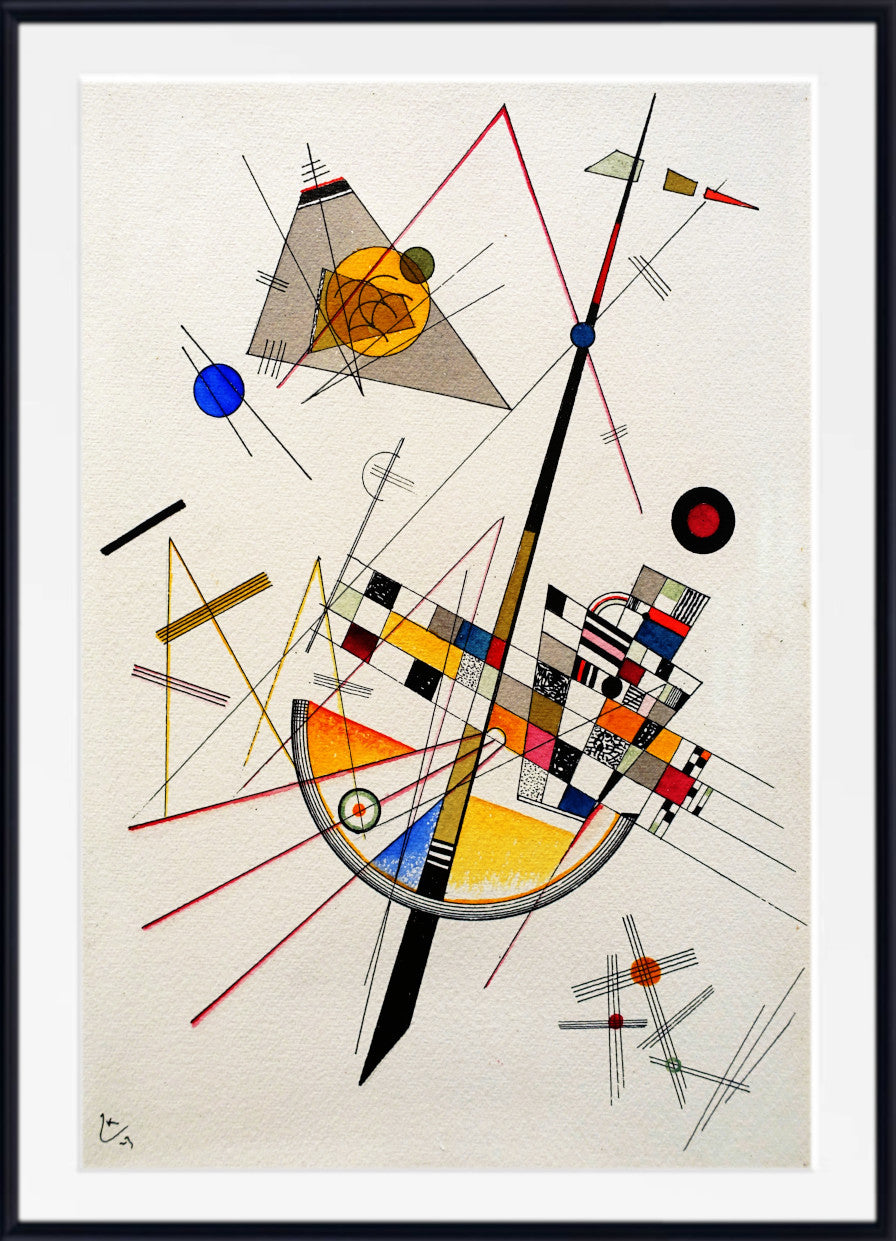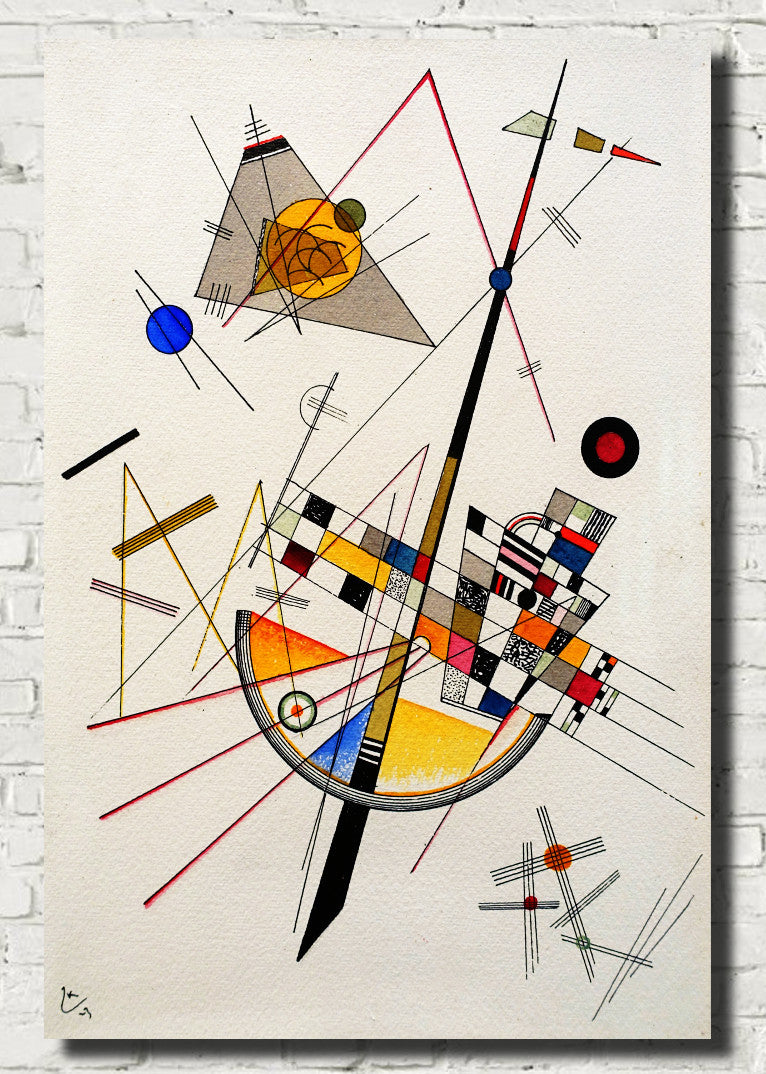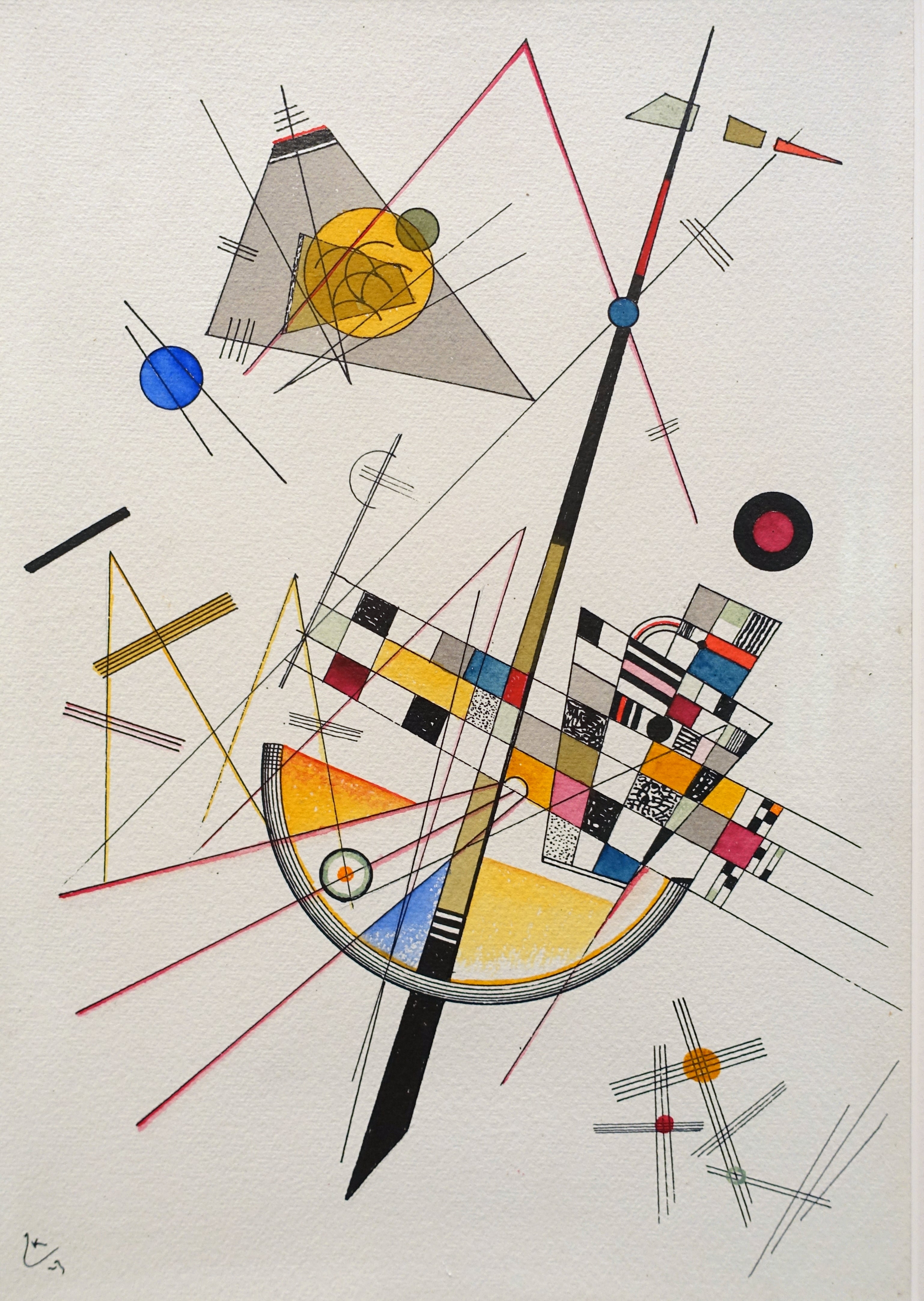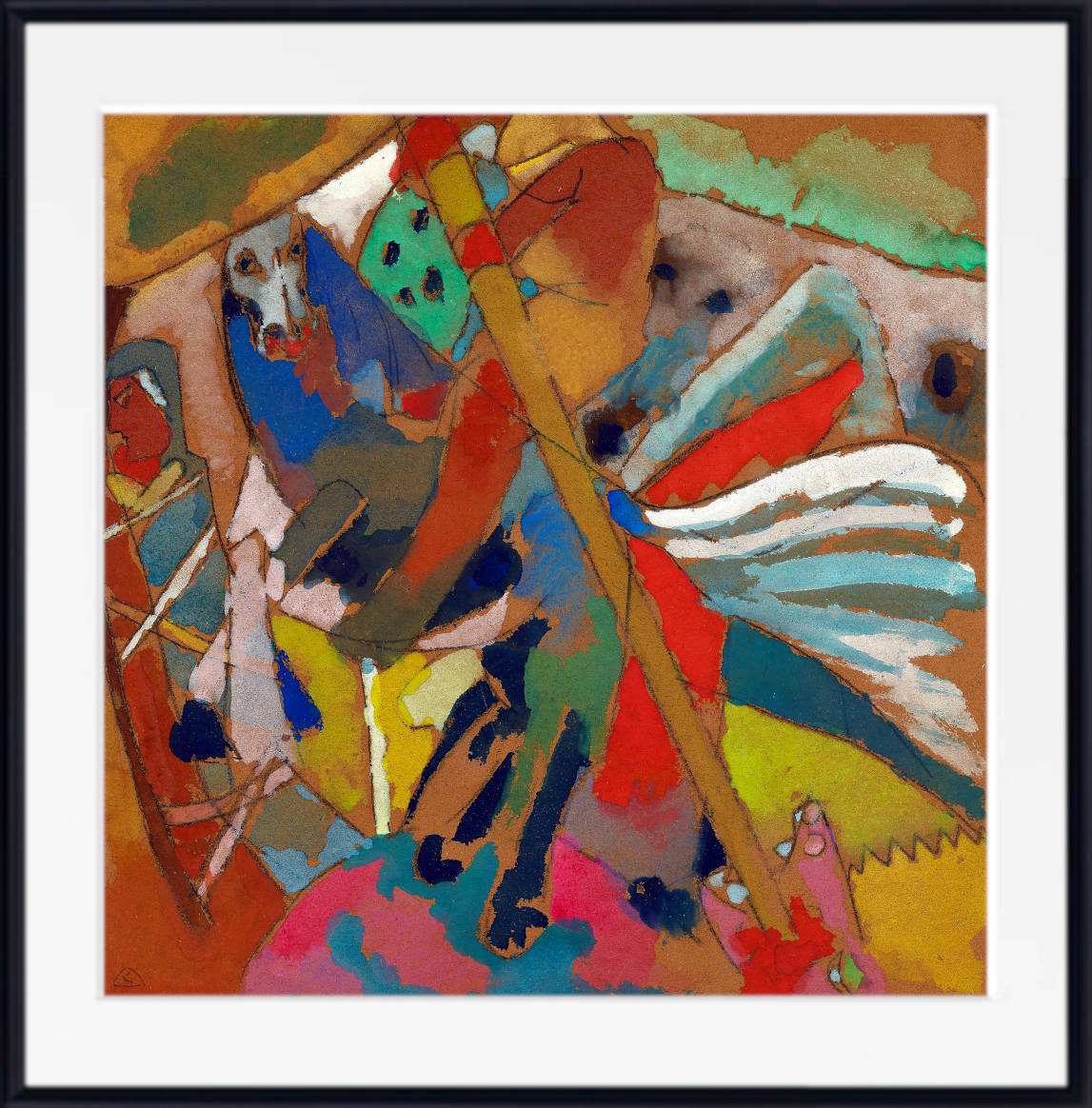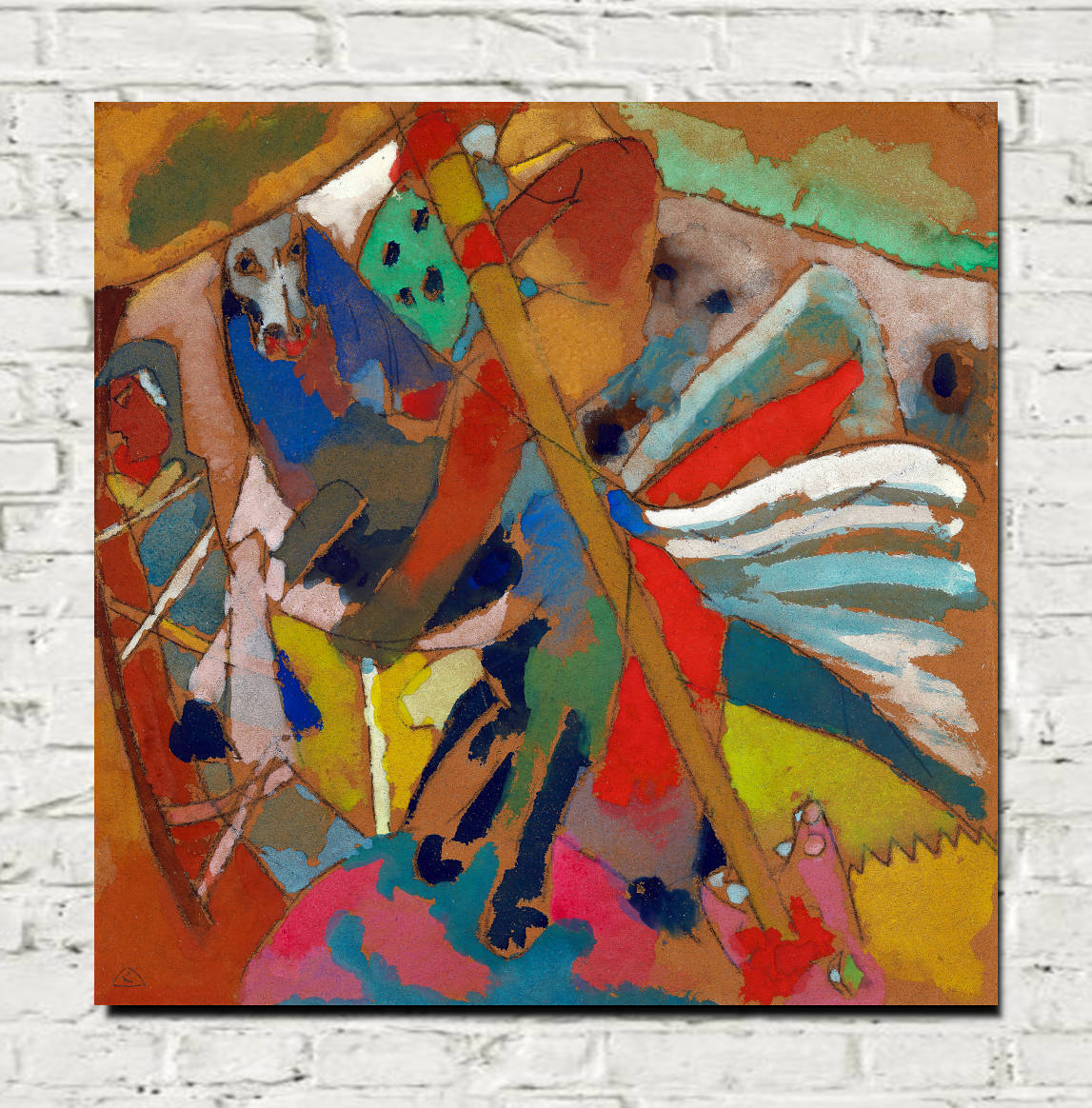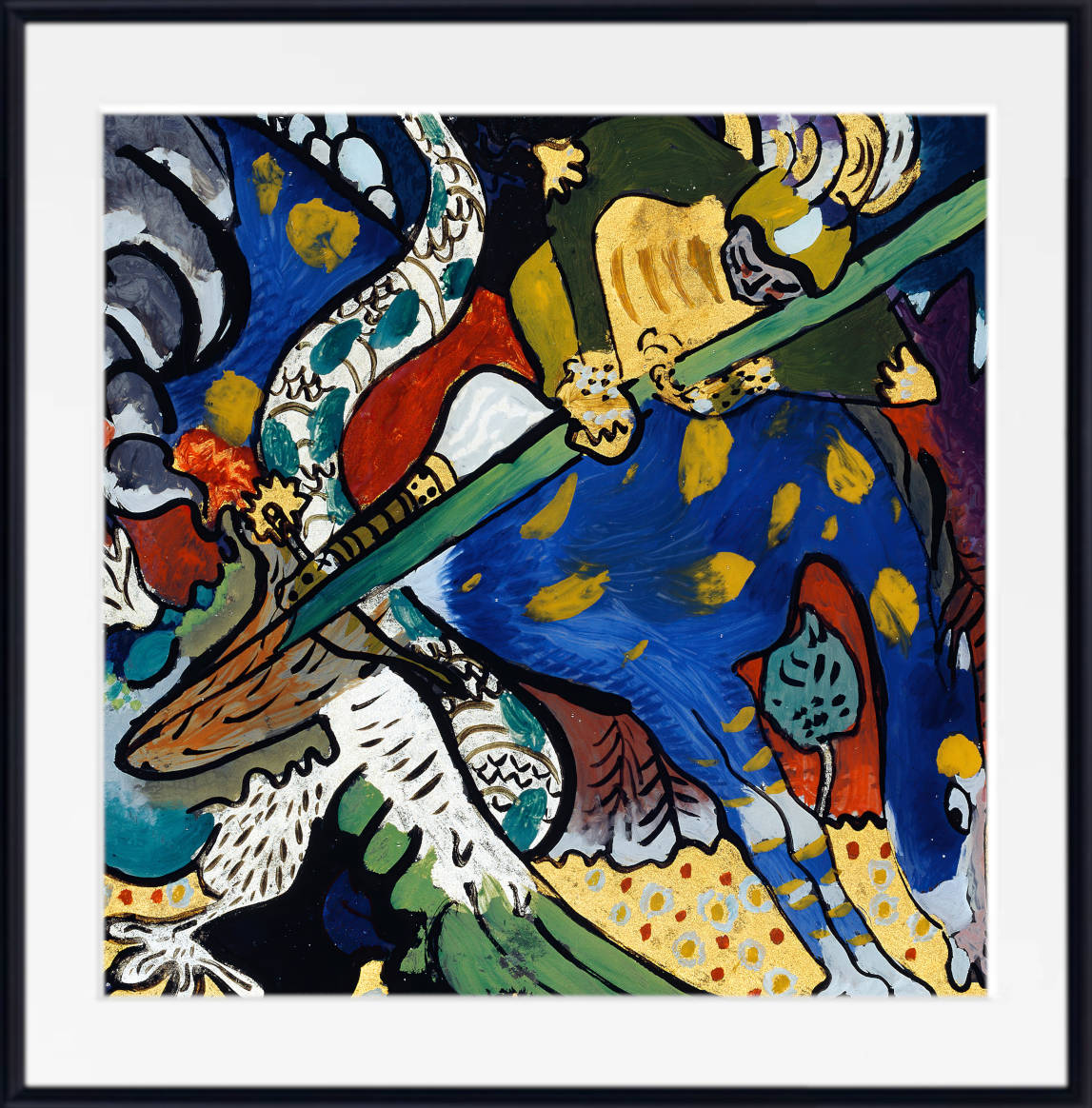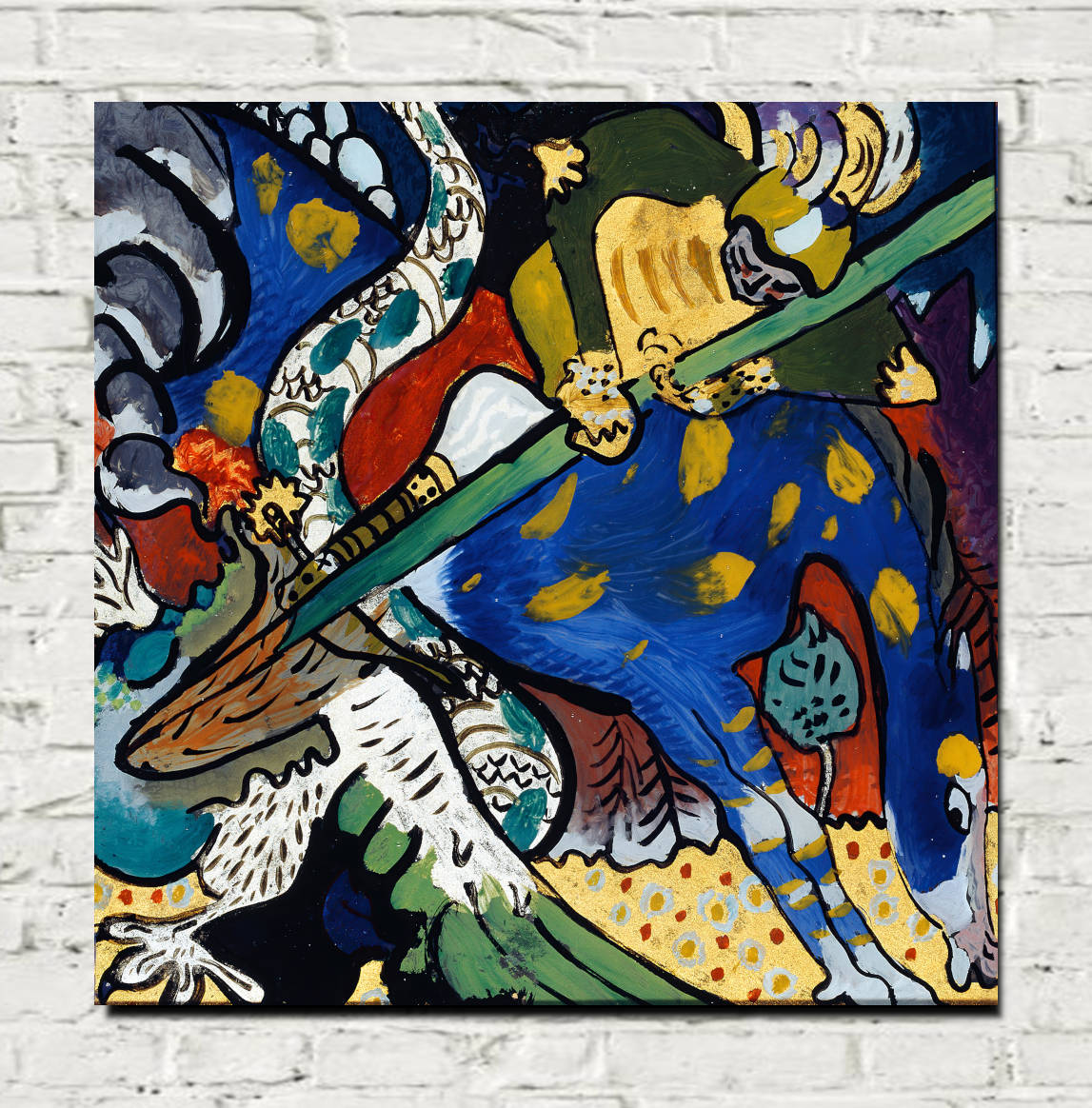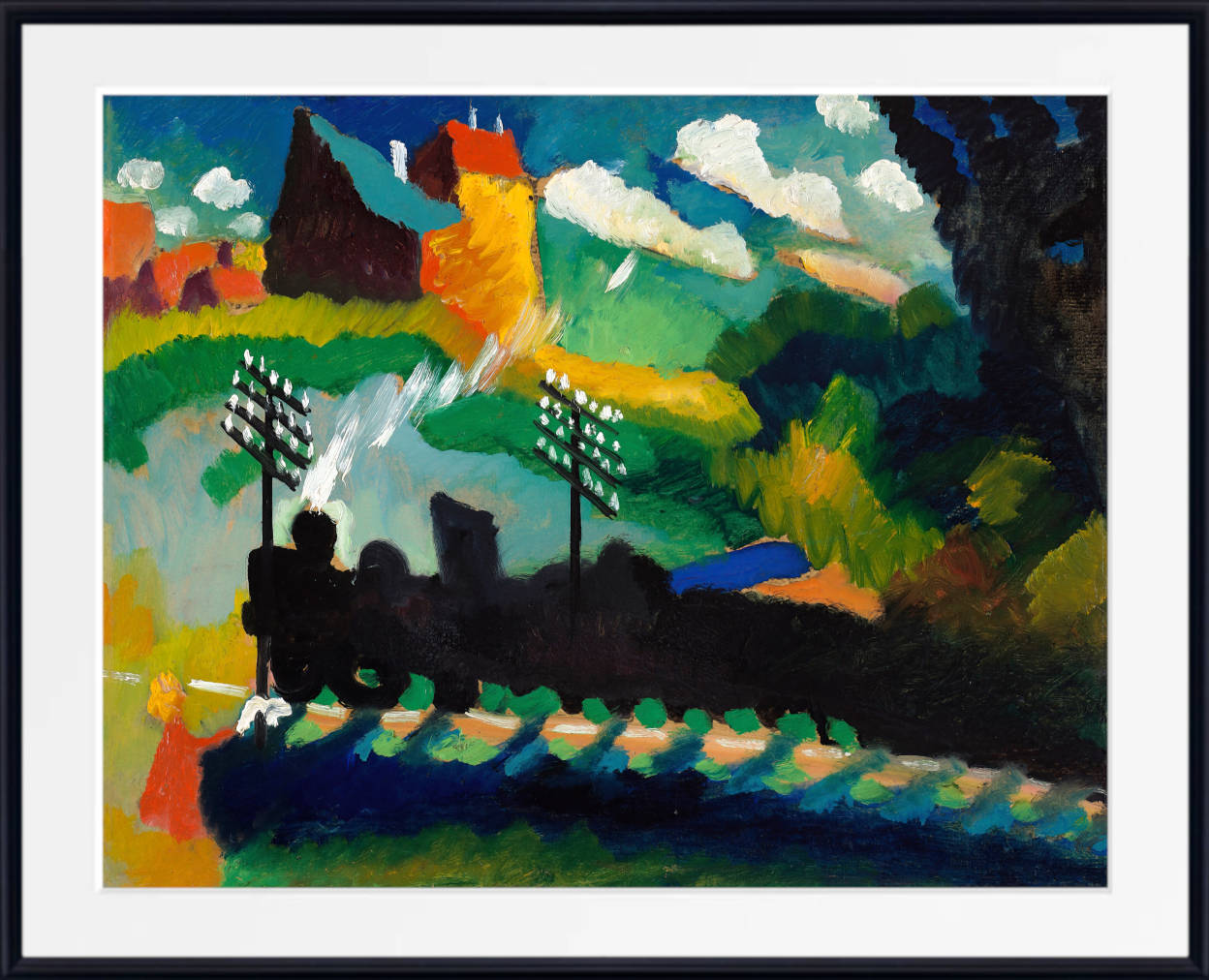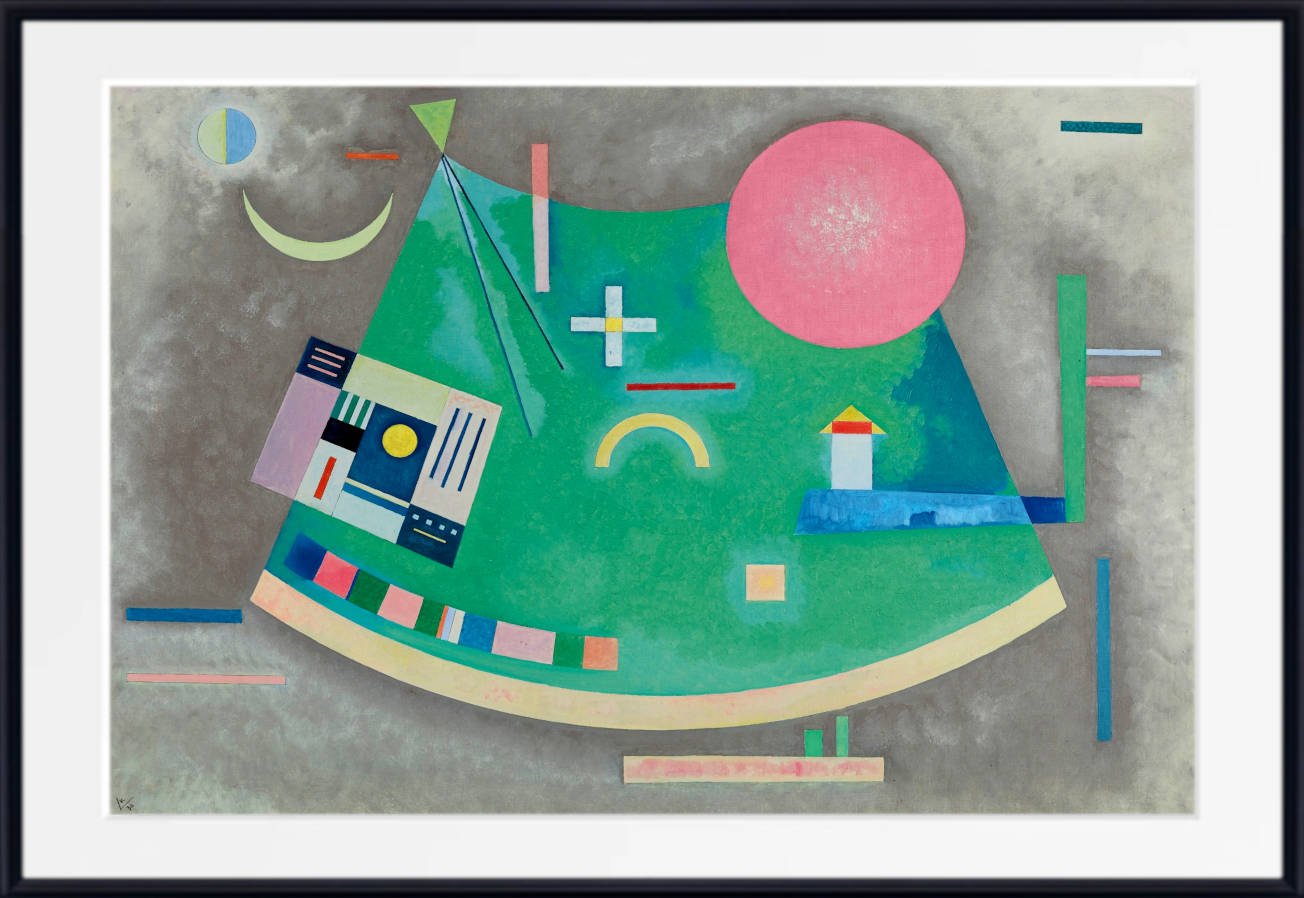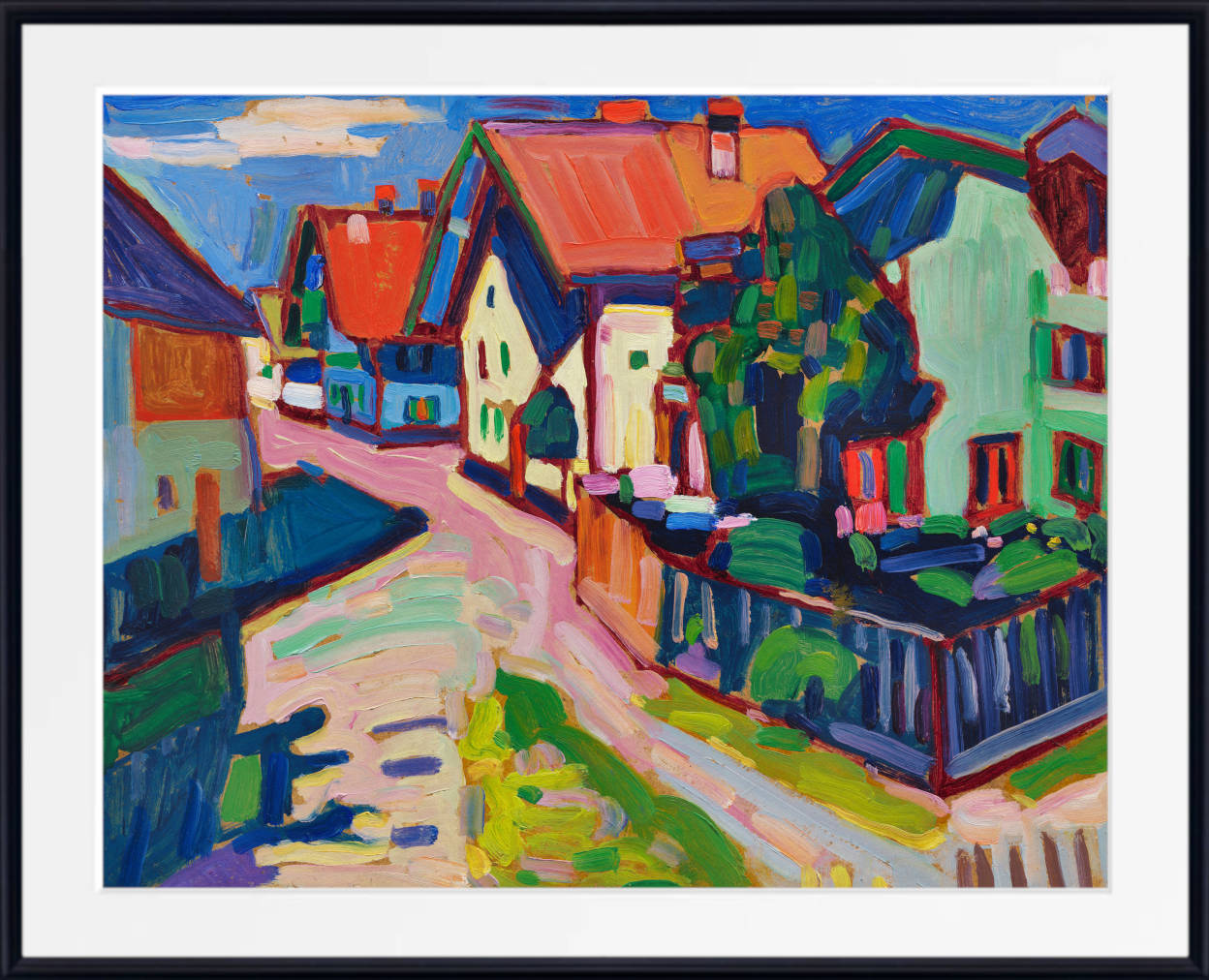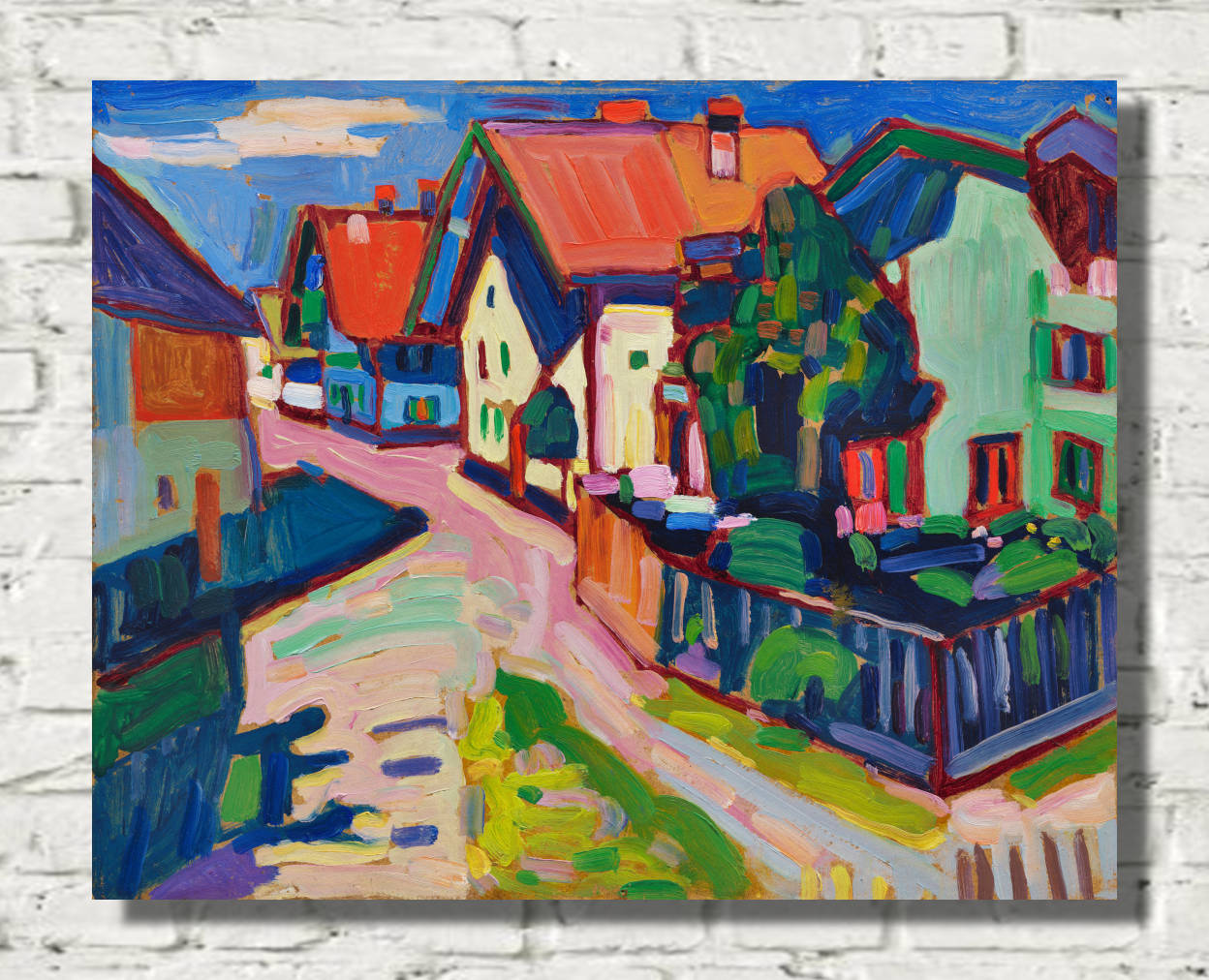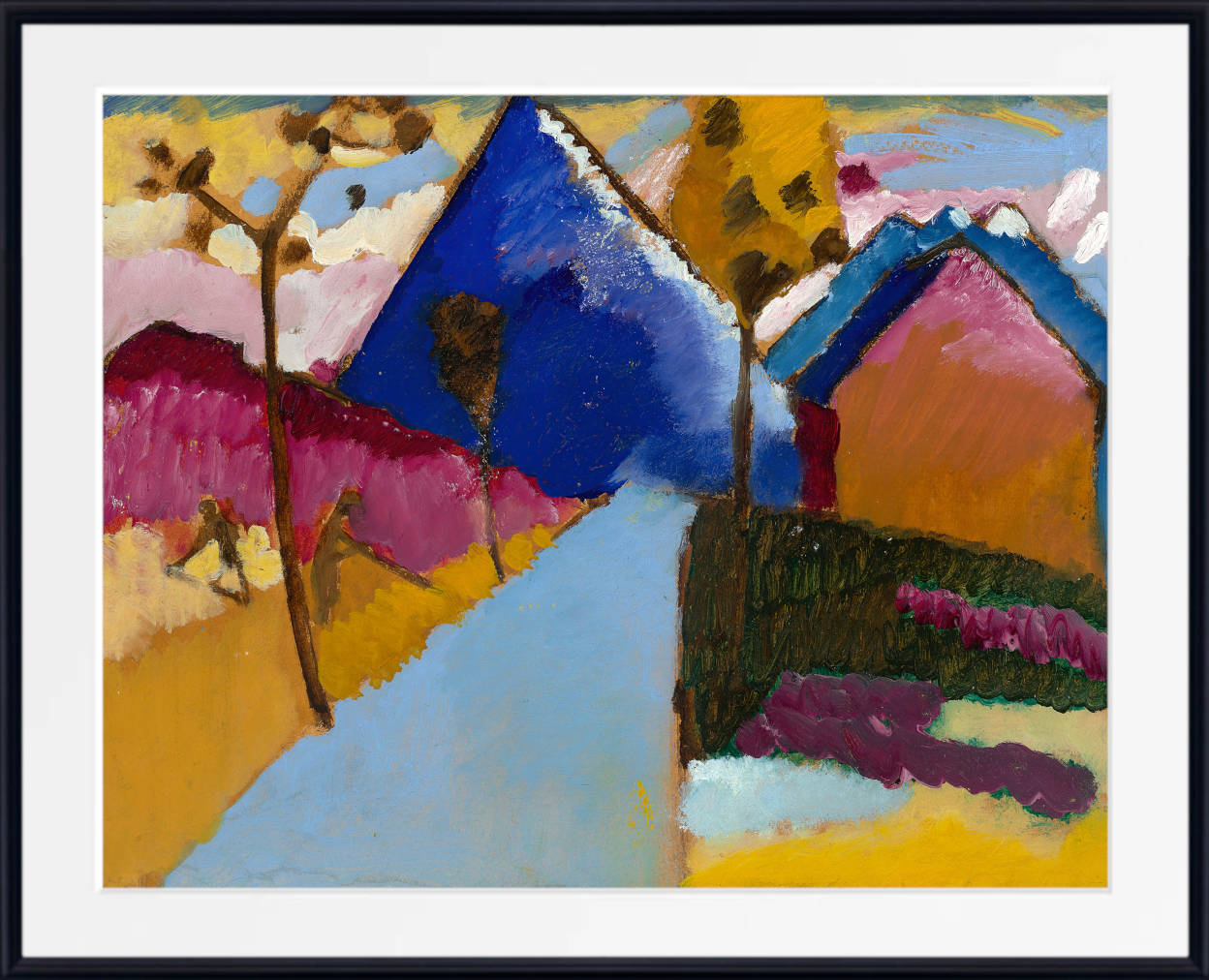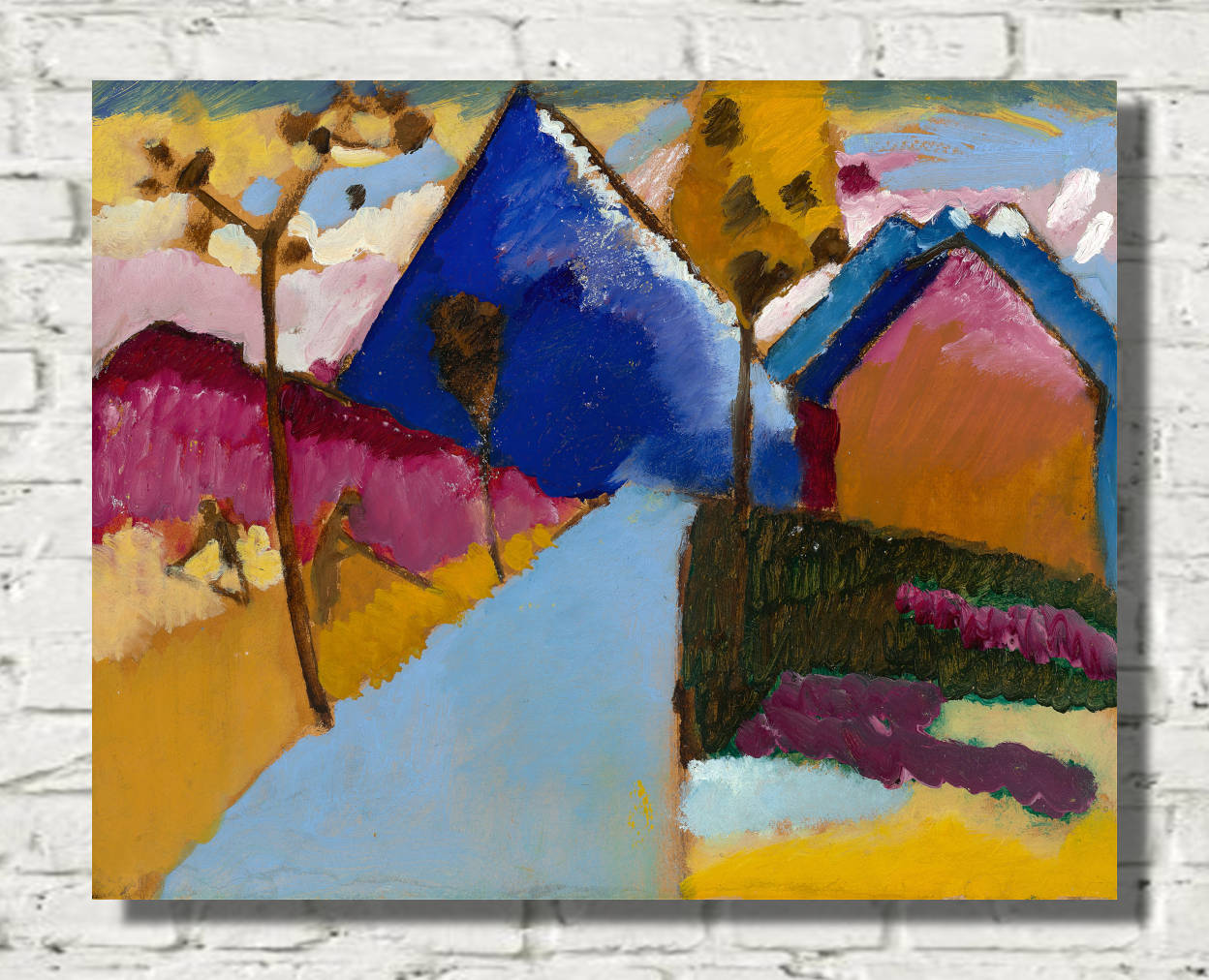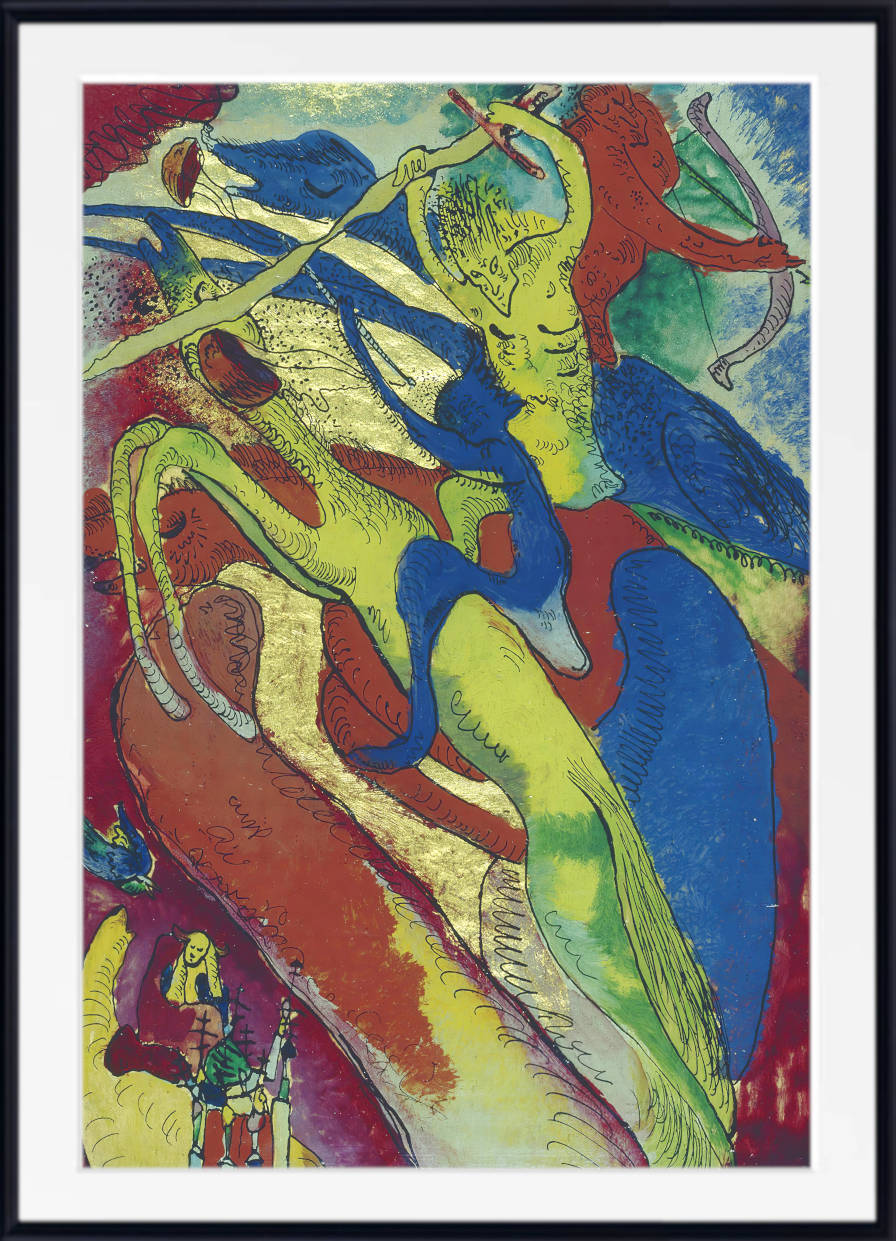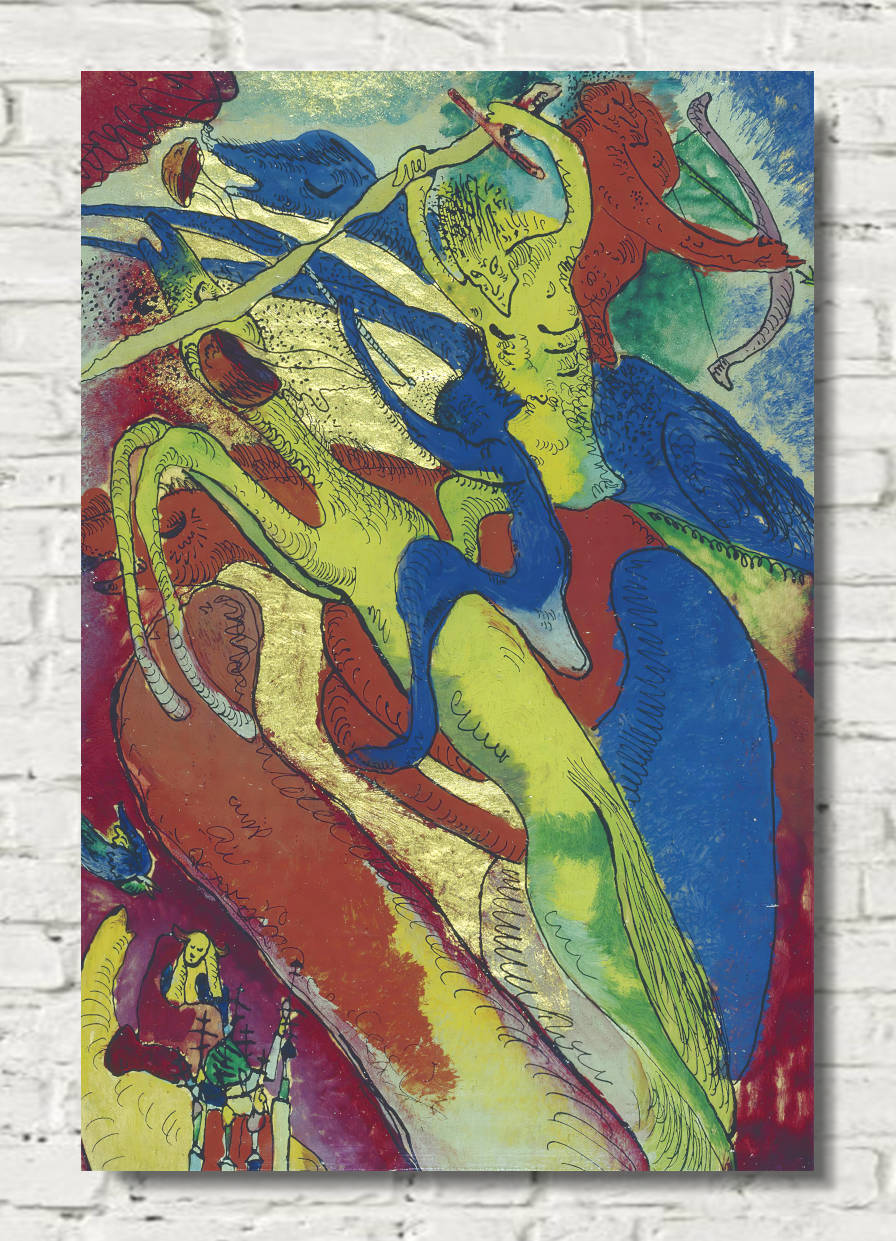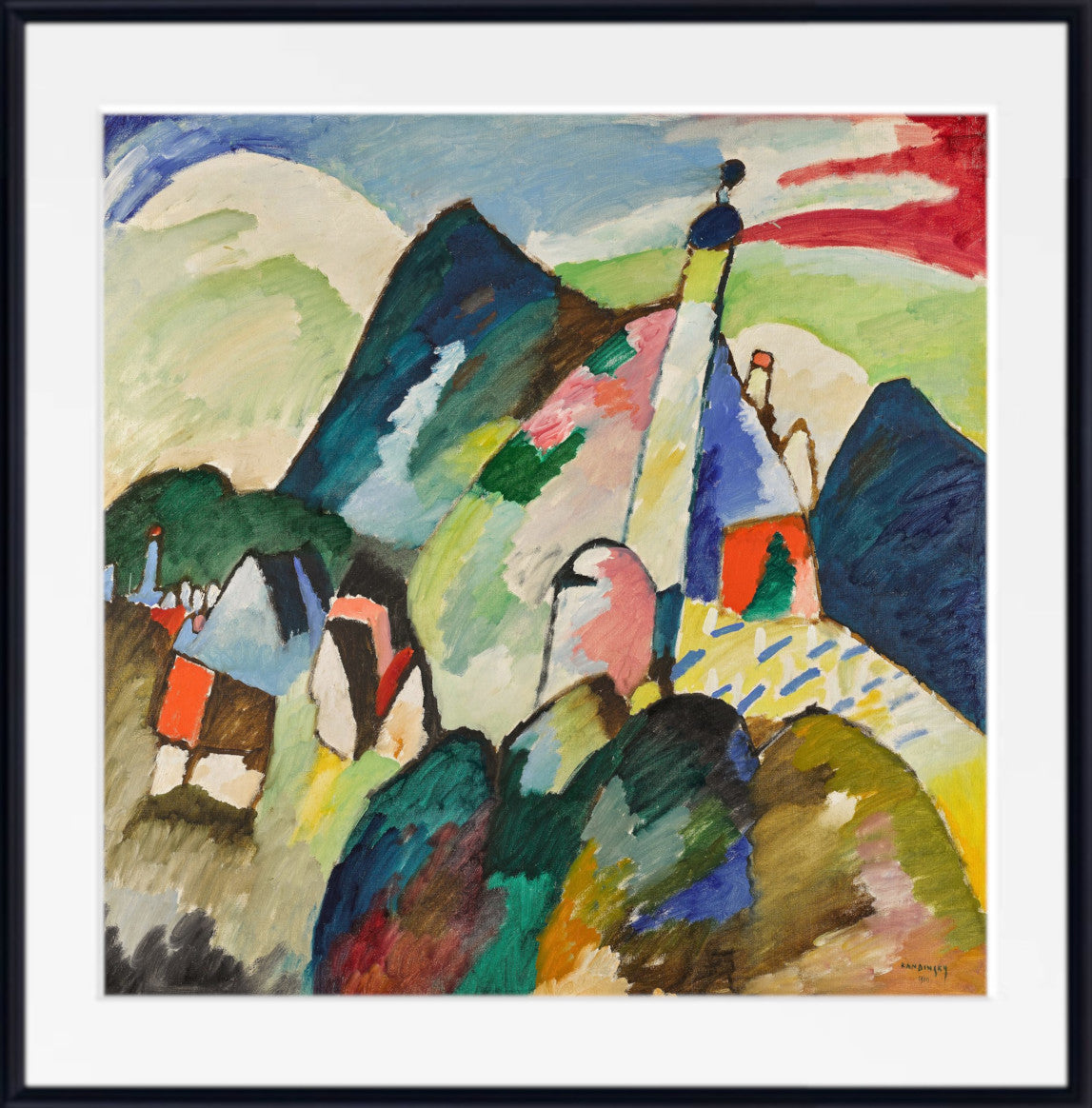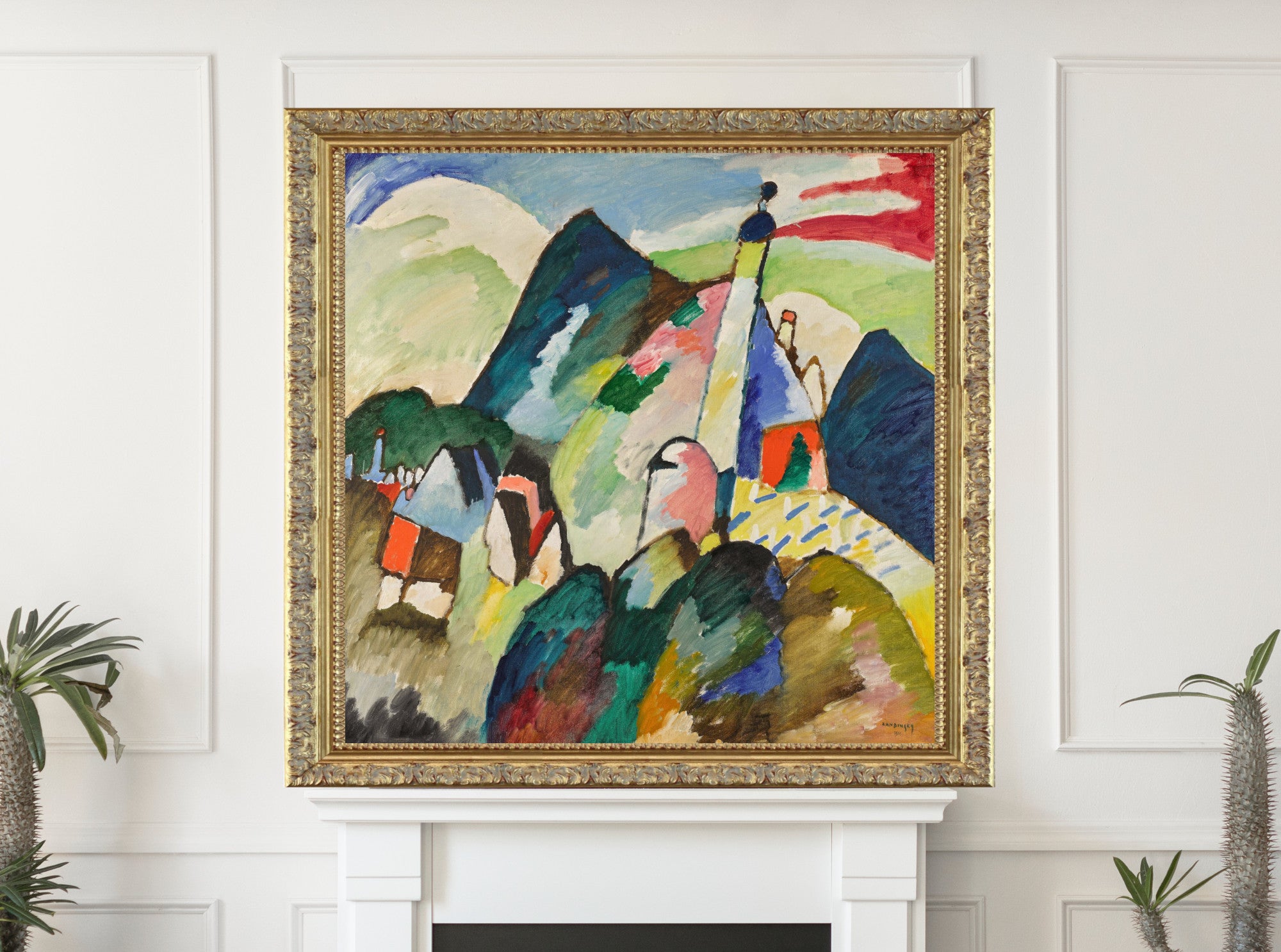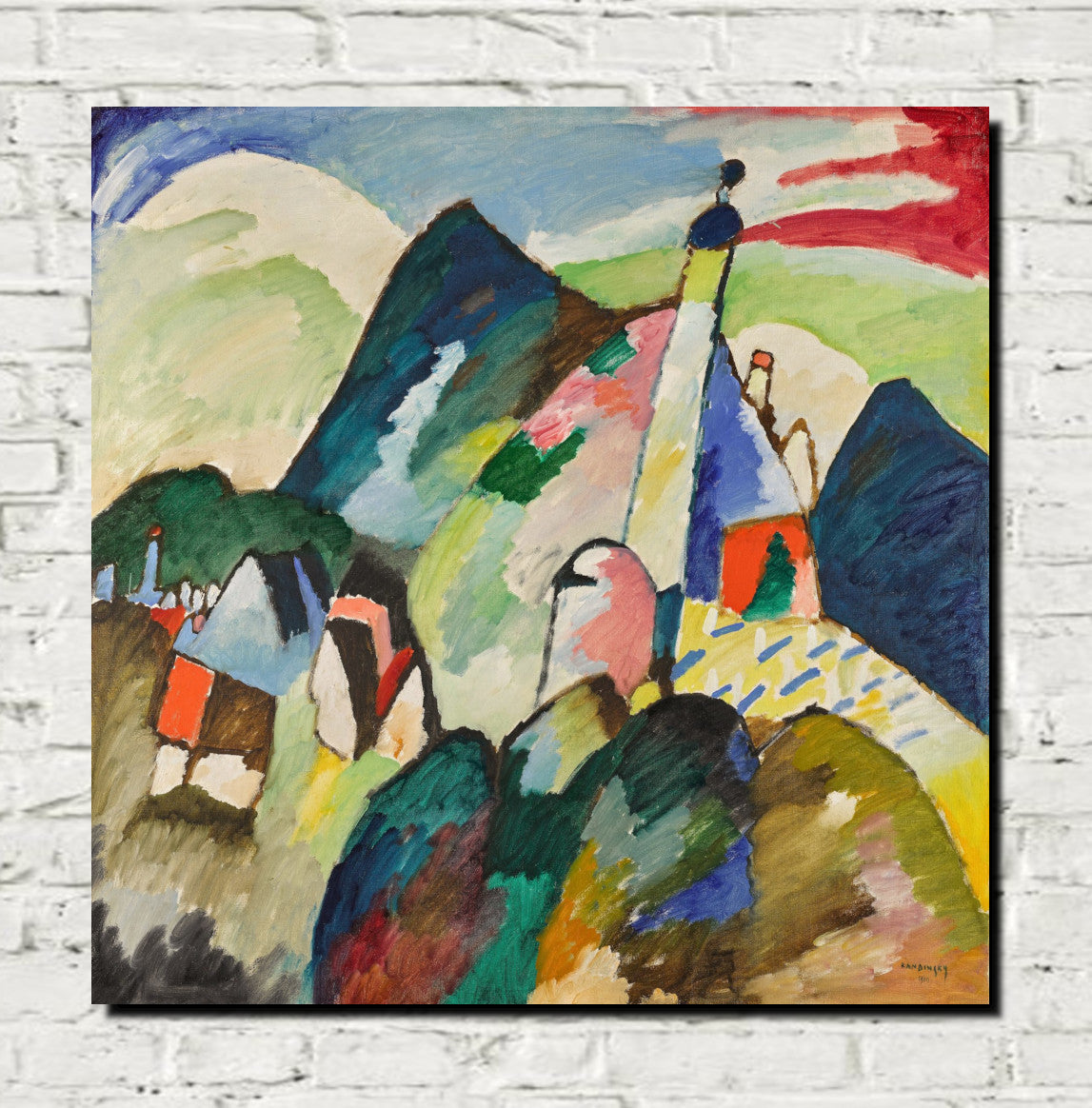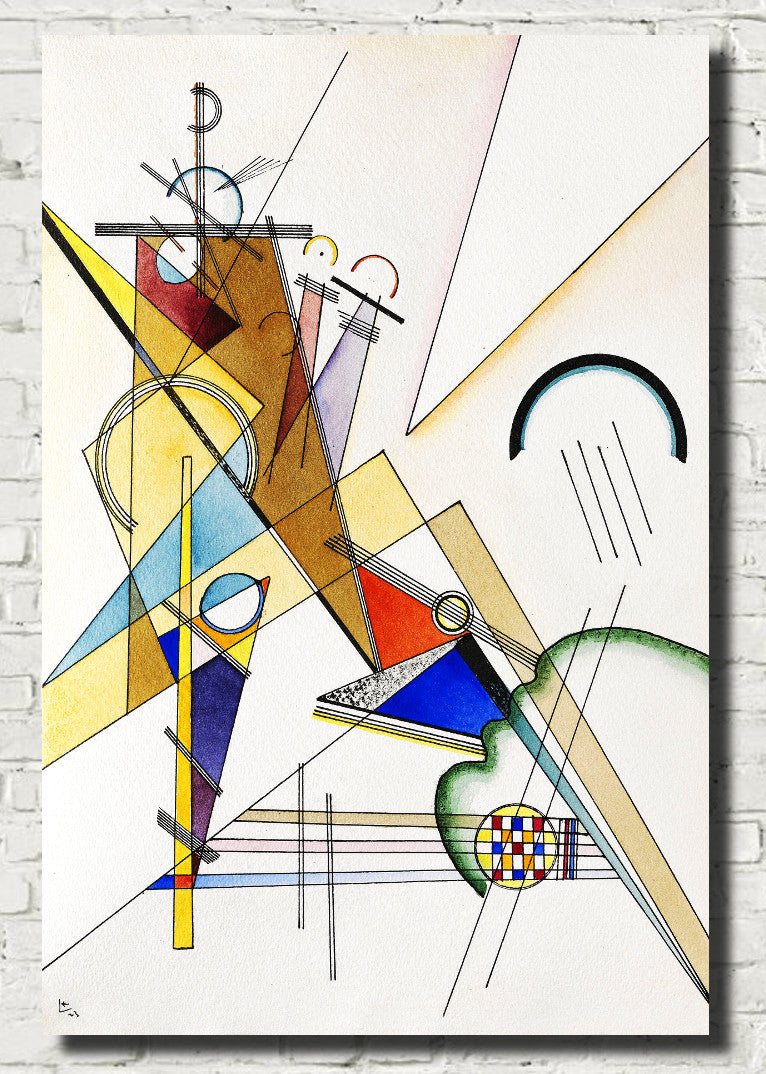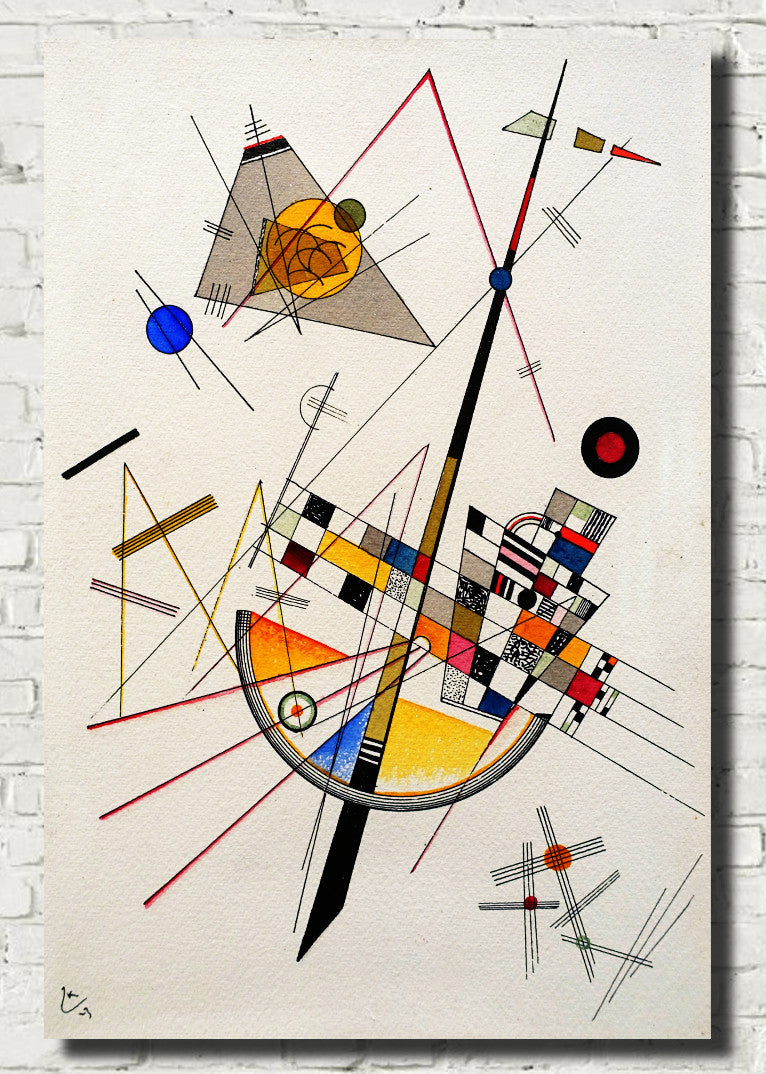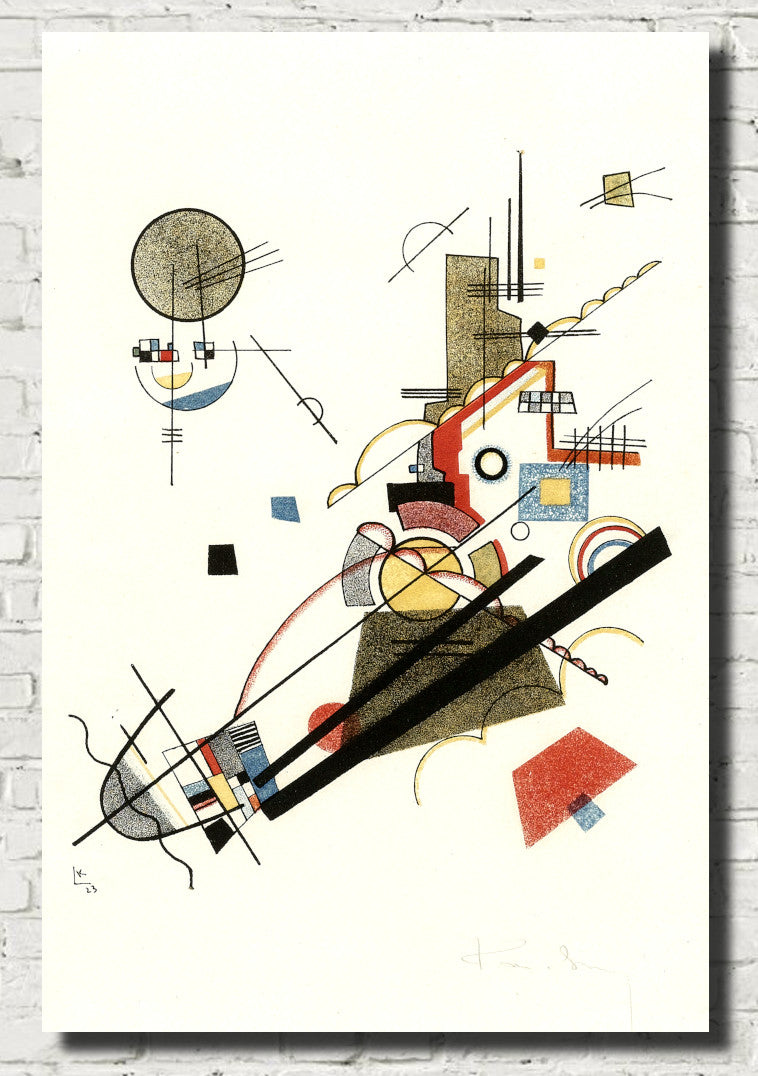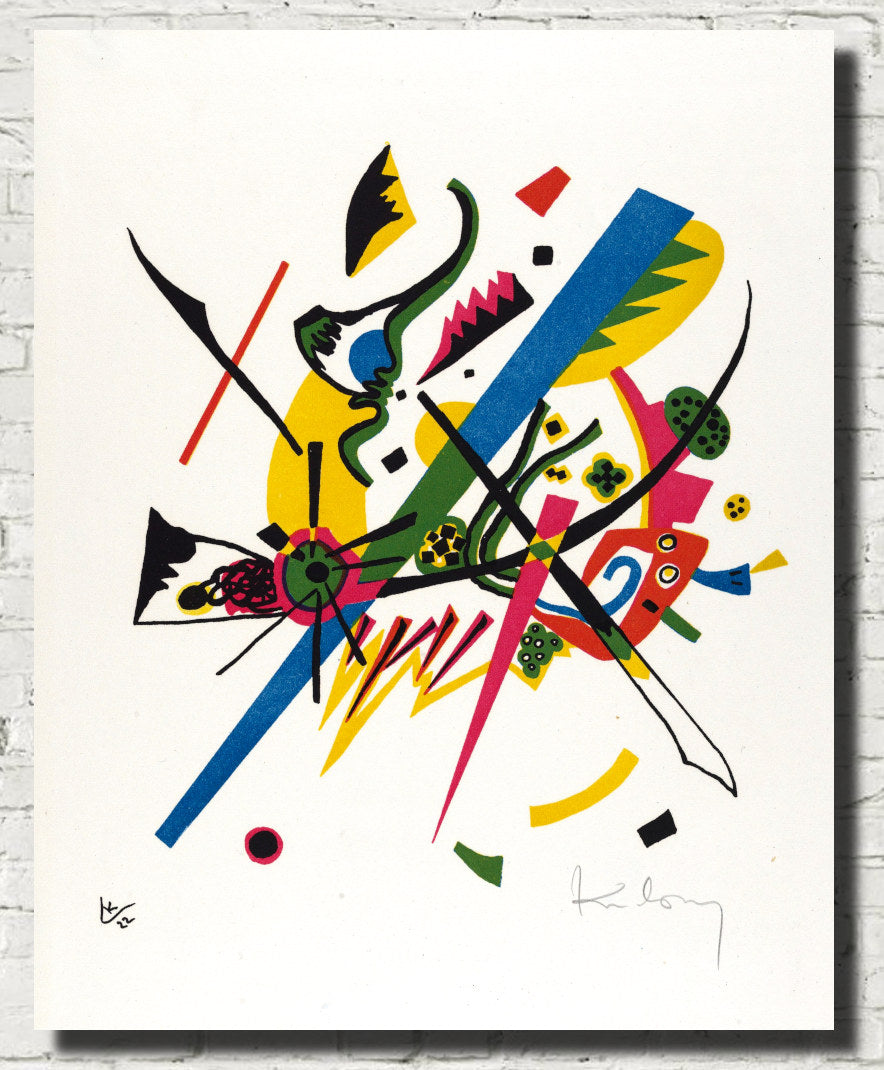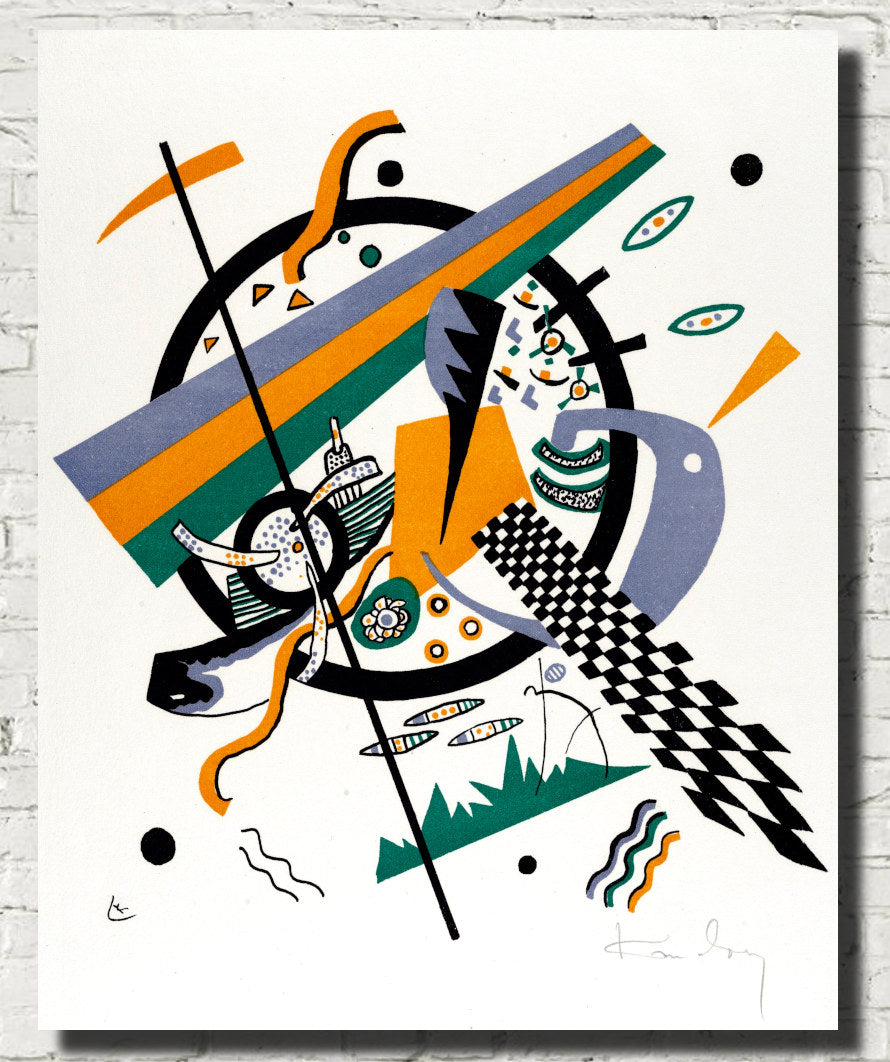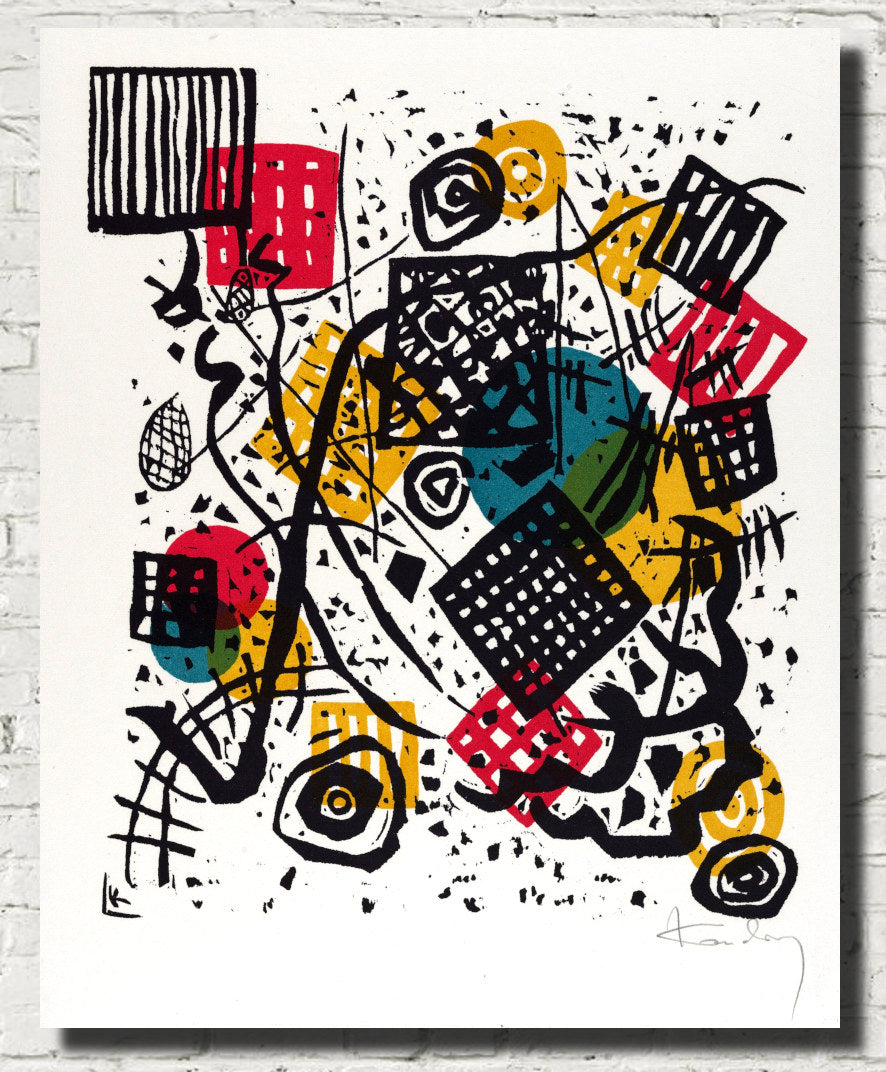Wassily Kandinsky (1866-1944) was a Russian born painter and art theorist credited as one of the pioneers of abstraction in western art. In 1893 he became Docent (Associate Professor) of Law Faculty and continued teaching. In 1896 the famous in Derpt University in Tartu, where at that time the process of russification was taking place, a thirty-year-old Kandinsky was appointed Professor to the Department of Law, but at this particular time he decided to give up a successful career to devote himself completely to painting. In 1896 he left for Munich, at that time considered to be one of the centers of the European art, and entered Anton Azbe's (Yugoslavian artist) prestigious private painting school , where he received the first skills in image composition, in work with line and form. Kandinsky viewed non-objective, abstract art as the ideal visual mode to express the "inner necessity" of the artist and to convey universal human emotions and ideas. He viewed himself as a prophet whose mission was to share this ideal with the world for the betterment of society. During his working life Kandinsky was associated with a number of famous painting groups.
Kandinsky - Small Worlds

Kandinsky made the Small Worlds (Kleine Welten) portfolio while teaching at the Bauhaus, the influential German art school founded after World War I. For Kandinsky, abstraction was a spiritual language. In these poetic images, he creates a vibrant interplay of line and form, while capitalizing on the strengths of each printmaking method, in order to evoke different sensations or "worlds." He used three techniques—drypoint, woodcut, and lithography—each of which had distinct, and for Kandinsky, symbolic, properties. Drypoint, which he regarded as "aristocratic," creates sharp, precise lines, while woodcuts produce a richer texture and depth. Contrasting with these traditional techniques is lithography, which the artist viewed as modern and "democratic" because it offered a smooth surface, a rich vocabulary of colors and marks, and the opportunity to create a seemingly endless number of impressions.
The publication of Small Worlds took place six months after Kandinsky had taken up a position as a teacher at the Bauhaus school in Weimar and as head of the mural workshop there. The series comprises twelve prints, which fall within a system governed by the three different print-making techniques used to create them: lithography, woodcut and etching (drypoint). This is to say that the series is ordered by a system of techniques that are mutually different from each other, and framed by a numerical ordering in which the three techniques are each represented by four prints, making up the total of twelve, a thinly veiled reference to other systems of cosmological ordering done in accordance with this symbolically charged number: hours, months etc. Thus, the twelve small worlds become parts of a greater totality. Small Worlds are abstract compositions, six of them polychrome, six monochrome, consisting of a range of different pictorial elements – sometimes geometric, sometimes amorphous. Some of the compositions appear to feature recognisable motifs, such as boat-like objects (sheets II and VI) or landscape elements (sheets I and II), while others have the diagrammatic appearance of maps in their combination of points, lines and planes (sheets VI and IX). Circles, or fragmented or approximate circles, feature in several of the prints (sheets III and IV), thereby accentuating the cosmological aspect – these are depictions of worlds. Diagonal lines are also much in evidence, adding visual tension and dynamism (sheets I, II, IV, VI, IX and XI) where centrifugal and centripetal energies seem to challenge one another. In a description of this series, Jan Würtz Frandsen has emphasised this play of forces, stating that ‘Kandinsky’s abstraction is the result of a process wherein the representational figures of his early paintings gradually become reduced to purely pictorial or iconic elements’, and also pointing towards their ‘pictorial energetics, generated by counter-movements’.2 Kandinsky articulates the actual picture plane, the graphic ground from which the figurations emerge, in various ways. Particularly in the last part of the series (sheets X–XII), the figures seem to move freely across the plane, which can either be read as something deeper, located behind the figures, or as something occupying the same level as the figures; it is immanent in the paper itself. In other cases Kandinsky marks out the image as something definitely delimited (sheets II and VI–VII), where a black ground nestles around, alongside and behind the central elements, and in sheet VIII he has a black line frame the inferno of intertwining pictorial elements that whirl around the centre of the image. An image can in itself be described as a microcosm, as its own little world acting through its own ordering principles, including its composition. Thus, we may describe Small Worlds as consisting of individual images that nevertheless have a formal kinship with each other – and in a sense a thematic one too insofar as we see them as abstractions on the same theme: cosmology. As in music, we find variations on a theme here, all of them different from the others: some seem more energetic than the rest, others have a deeper, even darker note (sheet VII), while yet others seem lyrical, almost playful (sheet XI).
It is worth noting that Kandinsky’s view of art links up the spatial and the symphonic, meaning the harmonious combination of voices, in the 1913 text Reminiscences, where he uses musical metaphors and cosmic elements such as the sun and stars to describe Moscow while also pronouncing the city to be a kind of symphony. He furthermore links the overall impression of the city to viewing a work by Claude Monet (1840–1926) from the latter’s series of haystacks – a well-known example of repeated imagery, although it is not the series as such, but an individual image that appears so incomprehensible, yet fascinating to Kandinsky, particularly because the actual subject matter seems to be absent:
"And suddenly, for the first time, I saw a picture. That is was a haystack, the catalogue informed me. I didn’t recognize it. I found this nonrecognition painful, and thought that the painter had no right to paint too indistinctly. I had a dull feeling that the object was lacking in this picture. And I noticed with surprise and confusion that the picture not only gripped me, but impressed itself ineradicably upon my memory, always hovering quite unexpectedly before my eyes, down to the last detail. […] I had the overall impression that a tiny fragment of my fairy-tale Moscow already existed on canvas."
This incipient abstraction, this absent subject, presents us with the question of what the picture did then, and whether it can then be said to be in harmony with other pictures in the series.

Kandinsky - Abstract Compositions
Kandinsky considered compositions as main declarations of his artistic ideas. They have a number of characteristics expressing this monumentality: impressively large size, conscious planning of composition and transcendence of presentation expressed by development of an abstract image. Just as symphonies are milestones in the career of a composer, the compositions of Kandinsky represent the culmination of his artistic vision at every moment of his creative career. "From the very outset," the artist wrote, "that one word "composition" sounded to me like a prayer." The first composition dates from 1910, the last one from 1939. Thus, the Compositions are a common thread running through all the work of Kandinsky, from his first steps on the way to abstraction to the last "biomorphic" Paris period. Unfortunately, the first three compositions were destroyed during the Second World War, and only their photos survived.

Composition IV (1911), Kandinsky Abstract print on canvas panel

Composition IX, Kandinsky Abstract print

Composition VIII, Kandinsky Abstract print

Composition V, Kandinsky Abstract print
Kandinsky - Famous Art Groups
After retiring from the studio of Franz Stuck, Kandinsky was looking for a group of progressive artists, with whom he could implement a new, “non-academic” exhibition policy. At that time, he met with the participants of the literary and artistic cabaret “Eleven of the executioners”, communication with who gave him new impulses for creativity. Kandinsky became to write critical articles, published in the Russian magazines. But the cultural life of the Munich seemed him too conservative, limited and narrow-minded. In an attempt to influence the prevailing situation of academism, as well as to collect in one company creative-minded people, in May, 1901 Kandinsky with Rolf Nitsky, Waldemar Heckel and Wilhelm Huisgen together created the artistic and creative association “The Phalanx”, becoming its President. In the art school opened at that time had taught participants of association. On the first exhibition of the “The Phalanx” the audience were shown works of Kandinsky, his friends from the artistic cabaret, as well as Alexander Salzmann, who Kandinsky had met in the studio of Franz Stuck. In the following exhibitions of “The Phalanx” Kandinsky tried to collect the work, which represented the other direction in art, in his opinion, were not enough assessed: impressionism, symbolism and jugendstil. It is jugendstil interested in of the artist at that moment. He felt that how were attractively new opportunities of generalized forms. One of the paintings of this period of searches is “The Old town”, as well as, later familiar “The Blue rider”. To the disappointment of Kandinsky, for the three years of intensive exhibition activity of an association, he was not able to cause the society a sufficient interest in what he was doing. Twelve exhibitions were conducted at all, in where works of both known and unknown artists had been demonstrated, presented of jugendstil, symbolism, the late impressionism. So, at the seventh exhibition (1903) there were presented works of Claude Monet, on the tenth (1904) - Toulouse-Lautrec, F. Vallotton, P.Signac, T.Rijsselberge. But the societym of Munich met the exhibitions in the best case in silence, in the worst - grumbling and swearing. Tired of fruitless attempts to break into their hearts and minds, Kandinsky, as President, had taken a decision on the closure of the association in 1904. He devoted entirely himself to the wooden engraving. This expressive technique gave him the opportunity to transfer their creative ideas, closely associated with jugendstil and symbolism - the currents, which at that time owned the soul of the artist and presented him the most free to choose artistic means. The period of “The Phalanx” had brought acquaintance and getting creative communication to Kandinsky with such an artist, as Alfred Кubin, a creator of the symbolic and surrealistic graphic creations, as well as poets-symbolists Stefan George, Karl Wolfskehl. They were close to Kandinsky in his quest to look for new ways in art. Thanks to the “The Phalanx” Kandinsky continued to search for a new style, opened for himself new expressive means and mastered a new technique - an engraving on wood. And the “The Blue rider” became later the symbol of another important phase in the life and work of Wassily Kandinsky.
At the end of the 1900 th, after the self-dissolution of ”The Phalanx”, Kandinsky had mainly lived and worked in Murnau. But here he comes back in Munich - and there he is waiting for a new stage of active creative and public activities. His energy is limitless. He is engaged in many projects: takes to write a book, which reveals his understanding art in, writes critical articles for magazines and, of course, constantly writes paintings. He visited salon of his good friend Marianne von Werefkin, and that is where the idea was born of a new artistic Union. “Munich New Artist's Association” ("Neue Kunstlervereinigung Munchen") was created in January, 1909. It was composed of friends Kandinsky - Munter, Verevkina, Jawlensky, Kubin, artists Adolf Erbsle, Alexander Kunoldt, Paul Baum, Moses Kogan, Vladimir Behteev and others, as well as art historians Henry Schnabel and Oscar Wittgenstein. It was a really active period of creative searching for Kandinsky, but he could also engage in exhibitions of ”The New Association”. The first exhibition was organized in December, 1909, and gathered 128 works of 16 artists, as members of the Association, and invited guests. The second exhibition held in the autumn, 1910, gathered interesting international team of masters: Georges Braque, David and Vladimir Burliuk, Kees van Dongen, Andre Derain, Pablo Picasso, Anrey Le Fokonje, Georges Rouault, and Maurice de Vlaminck. Conservative and sleepy Munich became temporarily the center of avant-garde art. Wassily Kandinsky presented to the audience the four paintings and six woodcuts. The most significant of the painting, written at that time of Kandinsky, was “Composition II", lost during the World War II. It became a demonstration of how the artist was released from the perspective, how he freely used the colors and lines. Group of figures, elements of a landscape - everything was blurry, all dynamically and uneven. Perhaps, this was the state of mind of the artist, who felt that the time comes decisive step forward. The reaction of the art critics of Munich was predictable. All with one accord sentence: the author was mad or “intoxicated with opium or hashish”. In defense of the exhibition were the only two: the Director of the Bavarian State Art collections- Hugo von Hop, and unknown at the moment anyone painter Franz Marc from Munich, who was a close view of Kandinsky in color and form. Later with him Kandinsky subsequently linked close friendship. The further evolution of the Kandinsky as an artist soon became a cause rejection of colleagues to unite. Many critical reviews of his work poured oil on the fire. When one of the exhibitions of “The Association” was canceled, the growing tension within the group led to the fact that Kandinsky had to leave his post as a Chairman. The guide association passed to Erbsle and Кunoldt, which showed a tendency to moderate cubism. The further aggravation of the relations within the group came owing to the pamphlet Karl Finnen “Protest German artists”, in which was expressed dissatisfaction with conservative figures of art pernicious influence of the foreign art (implied French and Russian). And the culmination of all was the third exhibition of “The New Art Association” (December 1911), its jury rejected the painting by Kandinsky “Composition V” on the grounds that his painting didn’t conform to the size established by the rules. The answer to that could only be output from “The Association”. Kandinsky made it and with him together - Franz Marc, Munter and Кubin. A little later “The Association” left Marianne von Werefkin and Jawlensky, and the organization had ceased to exist. Kandinsky and Marc to such outcome were ready. In the summer of 1911 they built already plans for the establishment of a new artistic Manifesto - in the future “The «Blue rider”. Soon on its basis a new Association will be created, on which Kandinsky will impose new creative hopes and which will mark for his breakthrough in abstract art.
Since the beginning of the 1900s and before the World War I, Kandinsky, living in Germany, regularly traveled to Russia: in Moscow, St. Petersburg, Odessa. He was keenly interested in the cultural process, took an active part in artistic life and has exhibited his works at various exhibitions. But first of all it attracted artists and associations, which, as he engaged in the search for new means and forms of expression. At the end of 1910 the public peace of Moscow was literally detonated the exhibition of “Jack of Diamonds”. The scandalous name of the event was offered by one of its organizers, Mikhail Larionov. “The Jack of Diamonds” was associated with something jargon-theft, and this is already the name of the caused irritation among the older generation of masters and conservative is public. They met the exhibition in bayonets. The contemporaries called it the “exhibition of madness”, the first “a slap in the face of public taste”. In contrast to prevailing at that time in the art of academism, as well as the later symbolism, “The Jack of Diamonds” sought to demonstrate a simple “art for the people”: deliberately vulgar, savagely energetic. This exhibition was the sign of the change of cultural codes. The fact that the senior masters seemed marginal, hooliganism, unacceptable - it was put up on the display and the general discussion. Kandinsky was among reproached and criticized participants. He put on court of the public the four of his “Improvisation”. Although his works weren’t entered in the general style of the exhibition - woodcut, deliberately simple, but they were consistent with the spirit of venture - the search for new means of artistic expression in contrast to the existing laws. M. Voloshin, visited the exhibition, wrote: "The sad fruits of the bitter theorizing of Kandinsky, who makes a heroic attempt to eliminate from his paintings all "objectivity" and the establishment of a line of "carpet", without ornaments, " the curious to the fact that they, indeed, from any point of view nothing can be understood, with the sincere desire to resolve these charades. But on the "carpets" these dry line, reminiscent of break band of iron, shot in the time of the crash of the train, not like." Another indignant reviewed Kandinsky received from the critic of P. Ivanovsky in the newspaper “The Early Morning". - "Here - W. Kandinsky , - And the audience, and fellow artists remember, of course, his bold, bright-color paintings, his graceful posters. This painter was in them. Then... then there was the "it"... and I, standing for ten minutes about these "Improvisations", nothing, absolutely nothing, understood. Someone from behind me said: “In the left corner of the painting, it seems, seeing a human face! …. And are as if feet to the right?” Once again, I looked closely at the "Improvisation". No. No face, any feet. There is nothing. Tell me, is it not terrible?" In January 1912, a few of the organizers of the exhibition have established artistic association “The Jack of Diamonds” and Kandinsky became its full member with David Burliuk, Konchalovsky, Lentulov, Mashkov, Rozdestvensky and others. In addition, Mashkov asked Kandinsky to attract of German artists in the association, where they, as he thought, would be interesting for the “The Jack of Diamonds”. At the exhibition “The Jack of Diamonds” in the same year, Kandinsky presented six his works, including – “George I”, ”Concert” and sketch for "Composition V”. On December 18, 1912 there was one more significant event in the cultural life: there was published a collection of poetry and the cubism-futuristic Manifesto “Slap in the face of public taste”. The text of the Manifesto was written by David Burliuk, V. Hlebnikov, V. Mayakovsky and A. Kruchenykh. Among the authors of that collection was a name of Wassily Kandinsky. However, his four poems were included in a book without his knowledge or consent. Kandinsky hastened to announce openly about it in the press. He also distanced himself from the Manifesto. In May, 1913 the Kandinsky left the association, he put it in a letter G. Walden, "disliked the situation and atmosphere of exhibitions, lectures". In general, participation of Kandinsky in this association was the phenomenon rather formal. "The first abstract watercolor" was written back in the 1910-th year and he was on the straight road to the opening of abstract painting. He chose moving forward and not to engage in an explanation of the critics of all kinds as "solve charade", where they weren't. In 1916 from the association came out Mashkov and Konchalovsky, and administrating was undertaken by representatives of more radical, approach to the art headed by Kazimir Malevich. The last exhibition of “The Jack of Diamonds” was held in 1917, and this year is considered to be the last year of the existence of association.
In 1911, while working at the Blue Rider Almanac, Kandinsky, together with a group of young Avantgardist artists, establishes an international association having the same name in Munich and Murnau. Franz Marc is one of the originators of the association, along with Kandinsky. The name came up during their conversation over coffee: they both loved the blue color in paintings, Marc liked horses and Kandinsky was fond of riders. The group comprises August Macke, Marianna Verevkina, Alexei Jawlensky, and Paul Klee. The Burliuk brothers, Gabriele Munter, and R.Delaunay, as well as a number of dancers and composers, also participate in the Blue Rider activities. The group takes an active part in the movement for renewal of the German art of the early 20th century. In this respect, they are consistent with the Bridge (another artistic association established in Berlin and Dresden several years earlier). The Blue Rider becomes a truly international community. Russians, Germans and Frenchmen are all united in their desire to create new art independent of existing rules and canons, and to withdraw from ‘the Modernist programme of the modern art which is externally oriented’. While representatives of the Bridge gravitate towards Figurative Expressionism, a lot of participants of the Blue Rider tend to abstract compositions, set colour-related, pictural and ornamental problems and seek associative solutions. The first exhibition of the association is held on 18th December 1911, in the Tannhauser Gallery, Munich. The paintings of different members of the group forming the exposition are very close to each other. The exhibited “Running Horse” by Campendonk was most likely inspired by Franz Makc’s creative wok (particularly, by the Large Blue Horses), Macke’s Storm takes over from Kandinsky’s tradition, while Kandinsky, in his turn, presents his colour experiments Composition V and Improvisation 22 to be judged by art lovers. In March 1912, the second exposition is held in H. Goltz Galley. Other groups of artists also take part in it including the Bridge, Suprematists and Cubists. In May of the same year the Blue Rider publishes an almanac (and distributes it during the Sonderbund exhibition in Cologne) where participants provide their reflections on the history and development of painting. Articles are accompanied by illustrations showing the commonality of ancient art in different parts of the world. The authors pay great attention to children’s drawing regarding it as rightful painting which was rather a revolutionary idea. The association also sticks to its principle of art synthesis: several columns are dedicated to music. Kandinsky’s work Concerning the Spiritual in Art where considerable attention is paid to the aesthetics of form and colour as well as the psychological role of hues, became the quintessence of those Blue Rider’s/ trends in art. During this period, figurativeness gradually vanishes from his works (With the Black Arc) and he creates colourful paintings which look like photographic phenomena embodied in paint. The second (and the last) almanac was published by the Rider in 1914. A year earlier, the last major exposition of the association takes place in the spaces provided by the Storm Magazine in Berlin. When World War I begins, Kandinsky leaves Germany and that is the end of the Blue Rider period in his biography. When its leaders break up, the group itself actually ceases to exist. In the 1920s, after the Revolution in Russia, Kandinsky returns to Germany, joins the Bauhaus School and meets some of his old companions from the Blue Rider (including Klee). However, the association was never revived in its original state.
Soon after his return to Germany at the end of 1921, Kandinsky received an invitation to become a teacher at the Bauhaus in Weimar. This was an experimental school-studio, where for the training of masters of applied a new system of education. Its founder, Walter Gropius, preached the idea of synthesis of arts, considering that the painting, architecture and sculpture should be combined together to create a “building the future”. In the manifesto 1919, he stated “the ultimate objective of all educational activity is the building! ... Between the artist and craftsman needn’t to be principal differences. Let's create a new workshop of craftsmen without scattering on classes of arrogance, striving to build a high wall between craftsmen and artists...” New ideas were close Kandinsky, and he gladly accepts the invitation. In 1922, he headed the Bauhaus workshop of painting. For organization of the training process Gropius gathered in the school the most modern and original artists. By the time of Kandinsky, there had already worked his friends Paul Klee, L.Feininger, as well as O. Schlemmer, G. Marcks, L. Schreyer and G. Muche. The training is conducted in parallel in the art and production workshops - this was the decision of Gropius. All students at first listen to a general introductory course, which reveals the theoretical fundamentals of the art, its formal elements. Then the students familiarize with more detailed materials, methods, tools. On the following courses they study the individual materials (wood, stone, glass, textile) in the creative workshops, and in the end all knowledge are combined in such courses as “Design” and “Construction and engineering skills”. Kandinsky in the Bauhaus read a few courses: «Analytical drawing», the main objective of which is to teach students to penetrate into the essence of things and understand abstraction; «the Basics of artistic design», which are, in fact, the theory of the design; and the most famous of his course “Colour”. In this course, Kandinsky teaches theory of color from the history of development of various color systems to modern psychology of perception of color. In his training course Kandinsky realizes a radically new approach to teaching about the color, based on the analysis of individual elements - a point, a line, a plane, and examining their relationships. The result of this analysis will be his work ”Point and line to plane”. The creativity Kandinsky’s Weimar period (1923-1925) is under the influence of ideas of suprematism and constructivism, which reign in this time in the Bauhaus. His main work in those years - a monumental “Composition VIII”. But to this period belong such a chamber, almost intimate picture as “Small dream in the red”, written in a gift to his wife.
In 1925 power of Weimar stoped subsidizing the Bauhaus because of attacks and criticism of right-wing political parties. The school moved to Dessau, active young city near Leipzig. Here for the school was built a new building, designed by Gropius. This building is considered to be one of the brightest examples of architecture of functionalism. Gradually program of school reoriented towards the practical needs of the construction. Also the content of the training courses is changed. Just in Dessau starts to develop a particular style of Bauhaus, which was manifested from the trend towards greater utilitarianizm and machine functionality. This functionalism, a pragmatic approach to art leads to conflict within the school. Supporters of aesthetics, Faininger, Klee, Kandinsky are under the fire of criticism for his approach to learning. Klee and Faininger go out, Kandinsky more and more withdraws from the teaching. In the same 1925, he creates two important paintings: “In blue” and “Yellow - red – blue”. The second painting marks the appearance of a new “cold romance”, which has become the main trend in his works of the Bauhaus’ period. Despite attempts by the management to make the ideology of the school of adequate political situation, it hasn’t success. Since 1931 a large-scale campaign of right-wing circles begins against Bauhaus, successfully concluded in 1932, when the school was closed, declaring it "a hotbed of bolshevism in culture". Family the Kandinsky’s makes a difficult decision - to leave Germany. They go to Paris, the city which will be the final stage of the creative and the way of life of Kandinsky. For some time the heads of the Bauhaus prolong its existence as a private educational institution in Berlin, but in 1933 the Nazis finally close the school. Many teachers migrate to the United States. In 1937 in Chicago was founded "the New Bauhaus" (Director was L. Mohoy-Nagy), and Gropius and Breuer organized at Harvard University's School of Design. The program of the Bauhaus had a huge impact on the development of art education and European art. Architects and designers of future generations continued to study the collections of scientific and theoretical articles teachers of the school. The Museum-archive of Bauhaus was founded in 1960, for which, in 1979, was built a special building in Berlin, projected by Gropius. At the present time in Dessau operates the design centre “Bauhaus-Dessau”.
Famous Kandinsky Art Quotes
- Everything starts from a dot.
- Every work of art is the child of its age and, in many cases, the mother of our emotions.
- To create a work of art is to create the world.
- An empty canvas is a living wonder... far lovelier than certain pictures.
- Each period of a civilisation creates an art that is specific in it and which we will never see reborn. To try and revive the principles of art of past centuries can lead only to the production of stillborn works.
- There is no must in art because art is free.
- The nightmare of materialism, which has turned the life of the universe into an evil, useless game, is not yet past; it holds the awakening soul still in its grip.
- Objects damage pictures
- The more frightening the world becomes ... the more art becomes abstract.
- Painting is a thundering collision of different worlds, intended to create a new world in and from the struggle with one another, a new world which is the work of art.
- Each color lives by its mysterious life.
- Color is the keyboard, the eyes are the harmonies, the soul is the piano with many strings. The artist is the hand that plays, touching one key or another, to cause vibrations in the soul.
- Color is a power which directly influences the soul.
- Color is the keyboard, the eyes are the harmonies, the soul is the piano with many strings. The artist is the hand that plays, touching one key or another, to cause vibrations in the soul.
- Color provokes a psychic vibration. Color hides a power still unknown but real, which acts on every part of the human body.
- The sound of colors is so definite that it would be hard to find anyone who would express bright yellow with base notes, or dark lake with the treble.
- The artist must train not only his eye but also his soul.
- A painter, who finds no satisfaction in mere representation, however artistic, in his longing to express his inner life, cannot but envy the ease with which music, the most non-material of the arts today, achieves this end. He naturally seeks to apply the methods of music to his own art.
- The artist is not a 'Sunday child' for whom everything immediately succeeds. He does not have the right to live without duty. The task that is assigned to him is painful, it is a heavy cross for him to bear.
- Music is the ultimate teacher.
- With few exceptions, music has been for some centuries the art which has devoted itself not to the reproduction of natural phenomena, but rather to the expression of the artist's soul, in musical sound.
- The deeper the blue becomes, the more strongly it calls man towards the infinite, awakening in him a desire for the pure and, finally, for the supernatural... The brighter it becomes, the more it loses its sound, until it turns into silent stillness and becomes white.
- Lend your ears to music, open your eyes to painting, and... stop thinking! Just ask yourself whether the work has enabled you to 'walk about' into a hitherto unknown world. If the answer is yes, what more do you want?
- Our epoch is a time of tragic collision between matter and spirit and of the downfall of the purely material world view.
- The spirit, like the body, can be strengthened and developed by frequent exercise. Just as the body, if neglected, grows weaker and finally impotent, so the spirit perishes if untended.
- That is beautiful which is produced by the inner need, which springs from the soul.
- Is beautiful what proceeds from an inner necessity of the soul. Is beautiful what is inwardly beautiful.
- Imagination is what allows your mind discover.
- All methods are sacred if they are internally necessary. All methods are sins if they are not justified by internal necessity.

Mountain (1909)

Composition with 3 Spots (1914)

Pointes Noires (1937)

Points (1920)

Soft Pressure (1931)

























